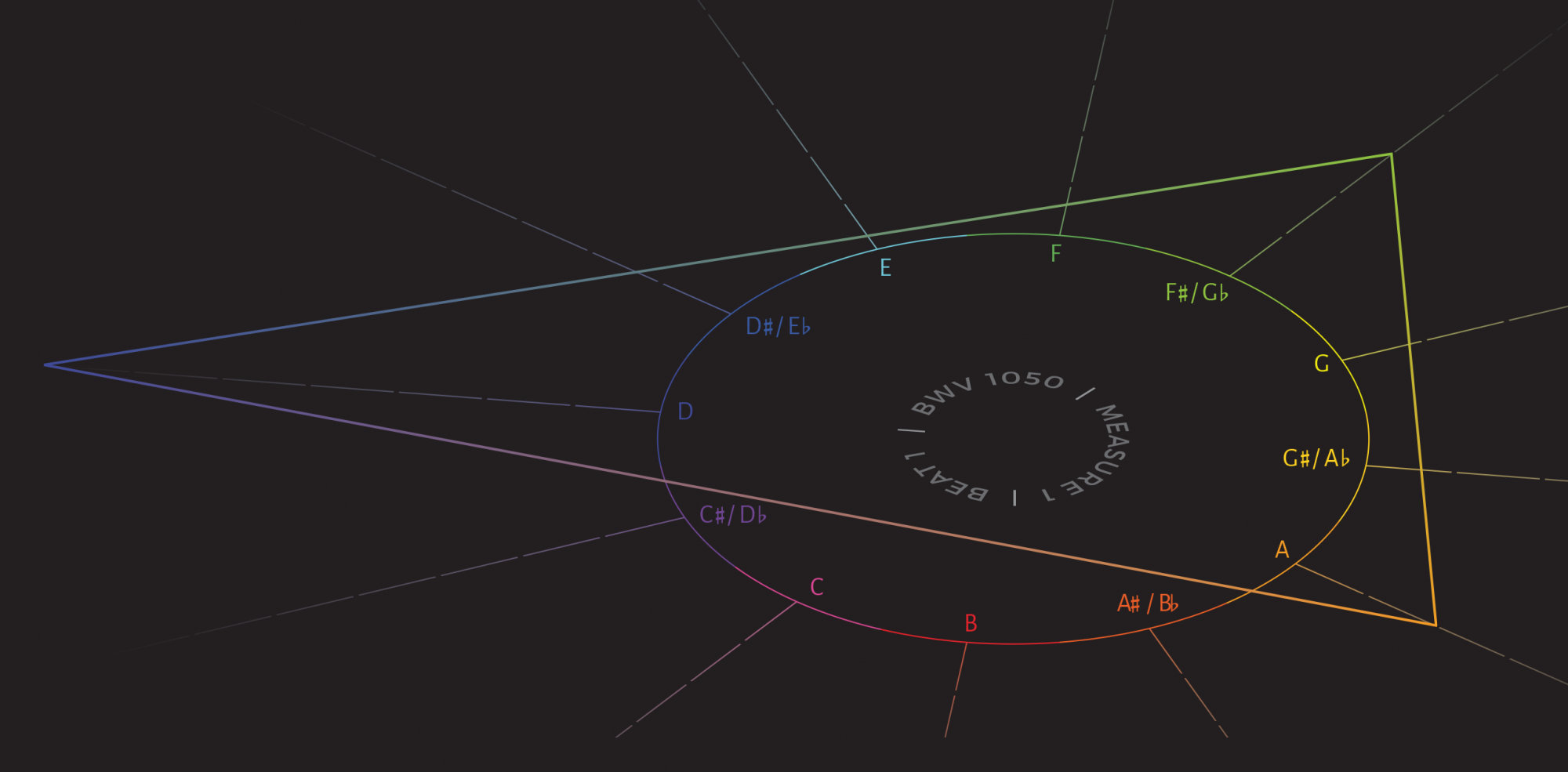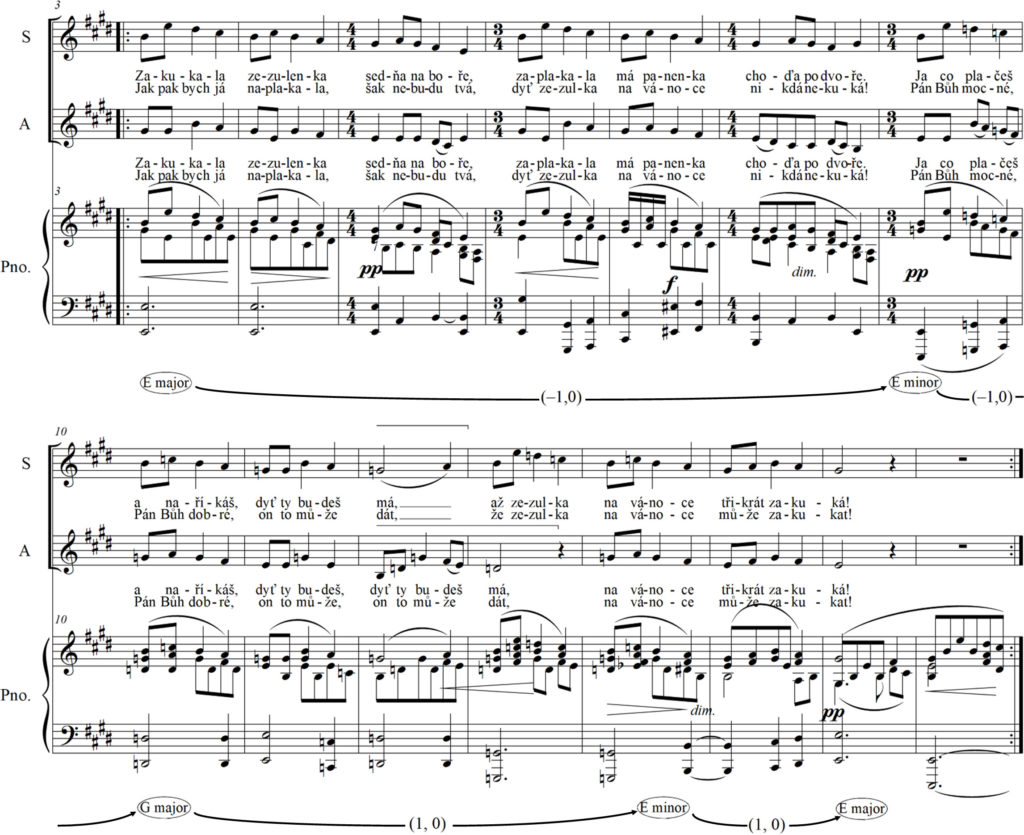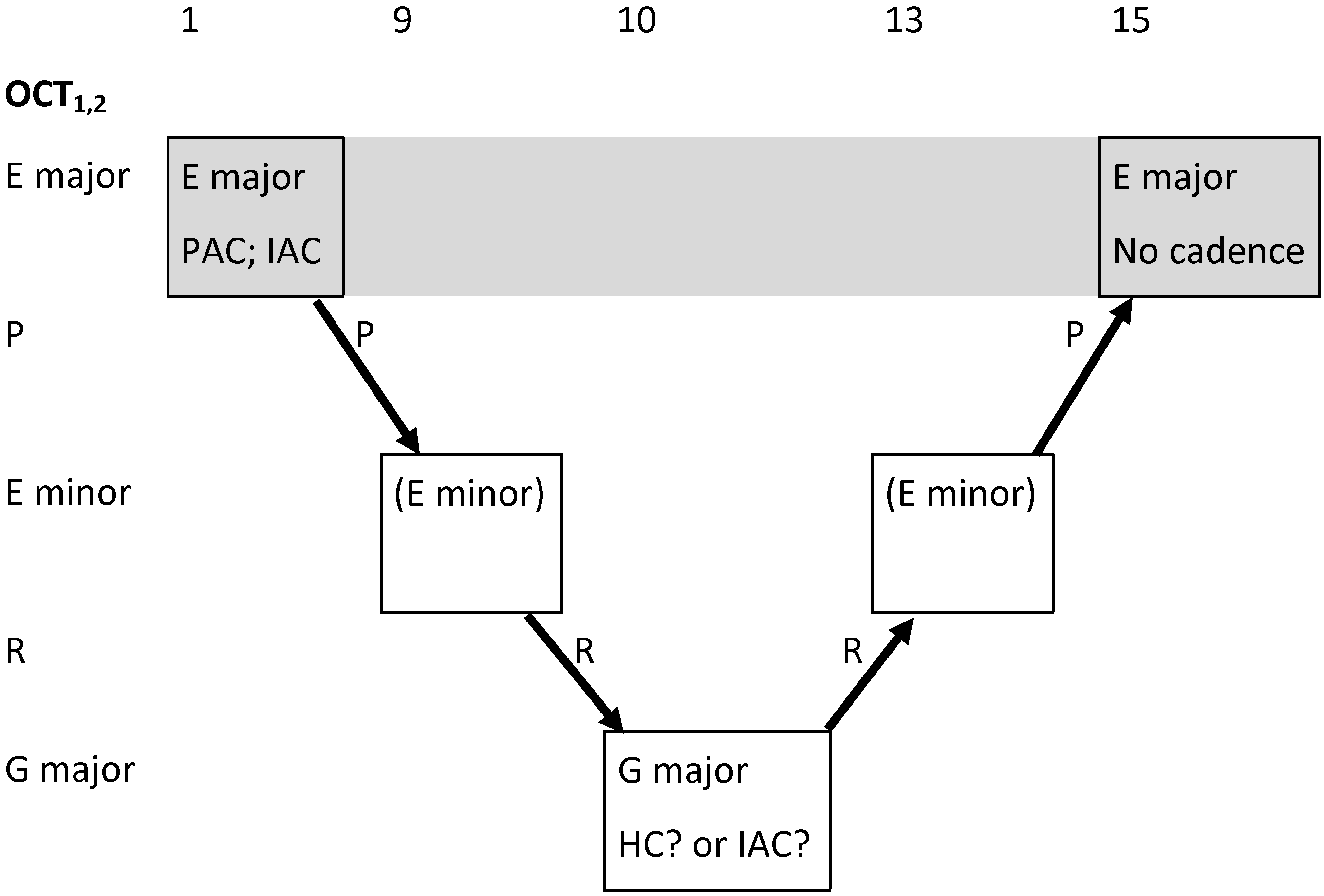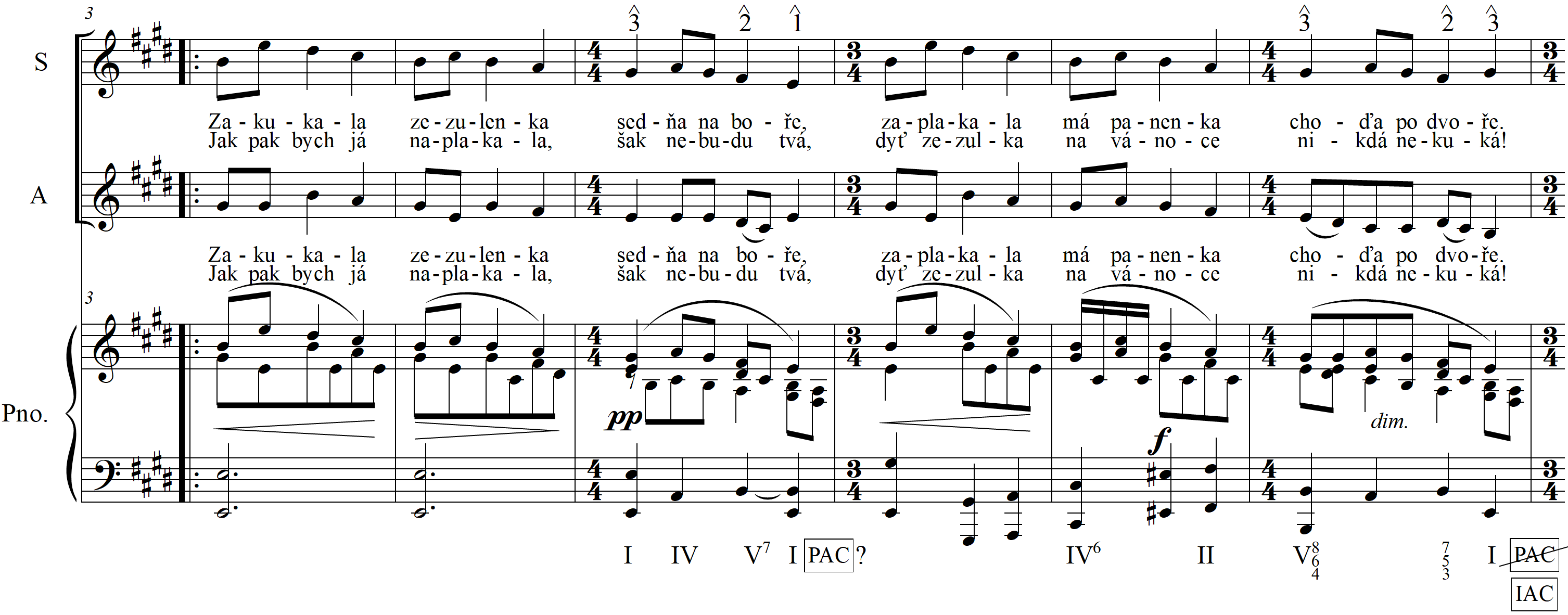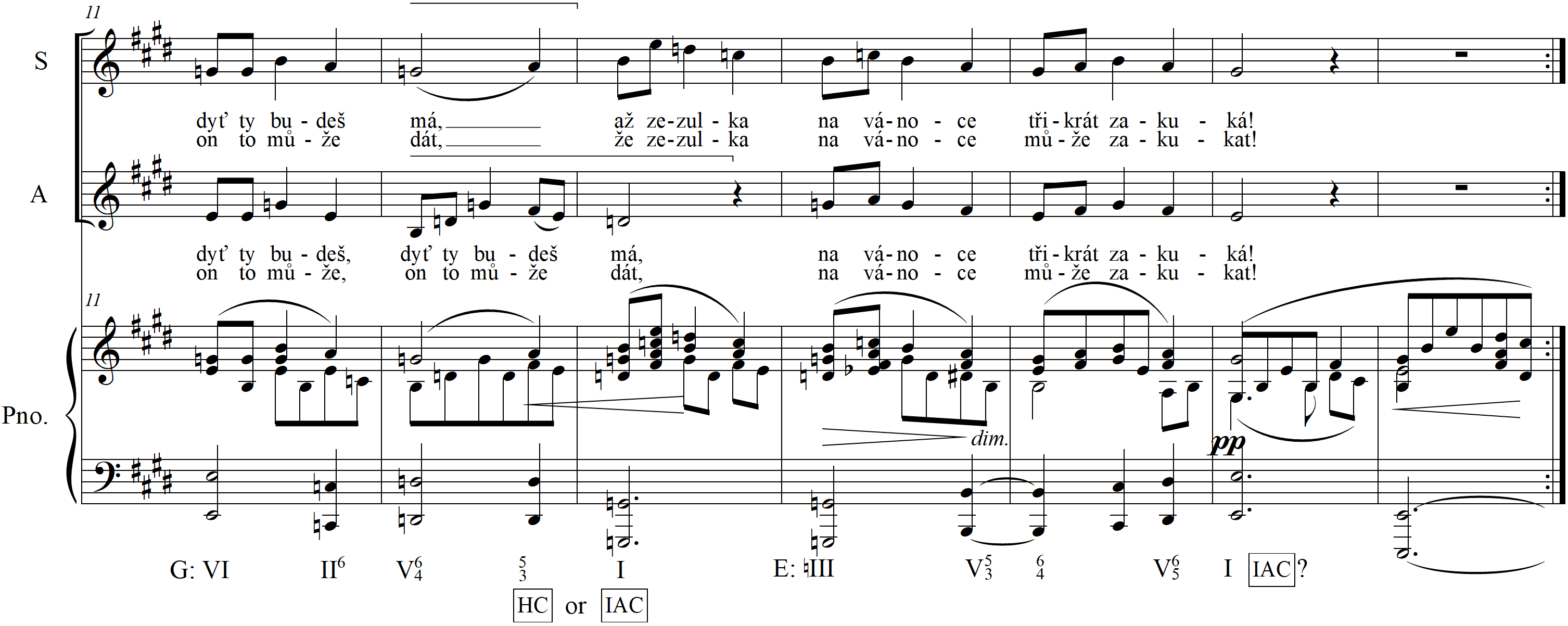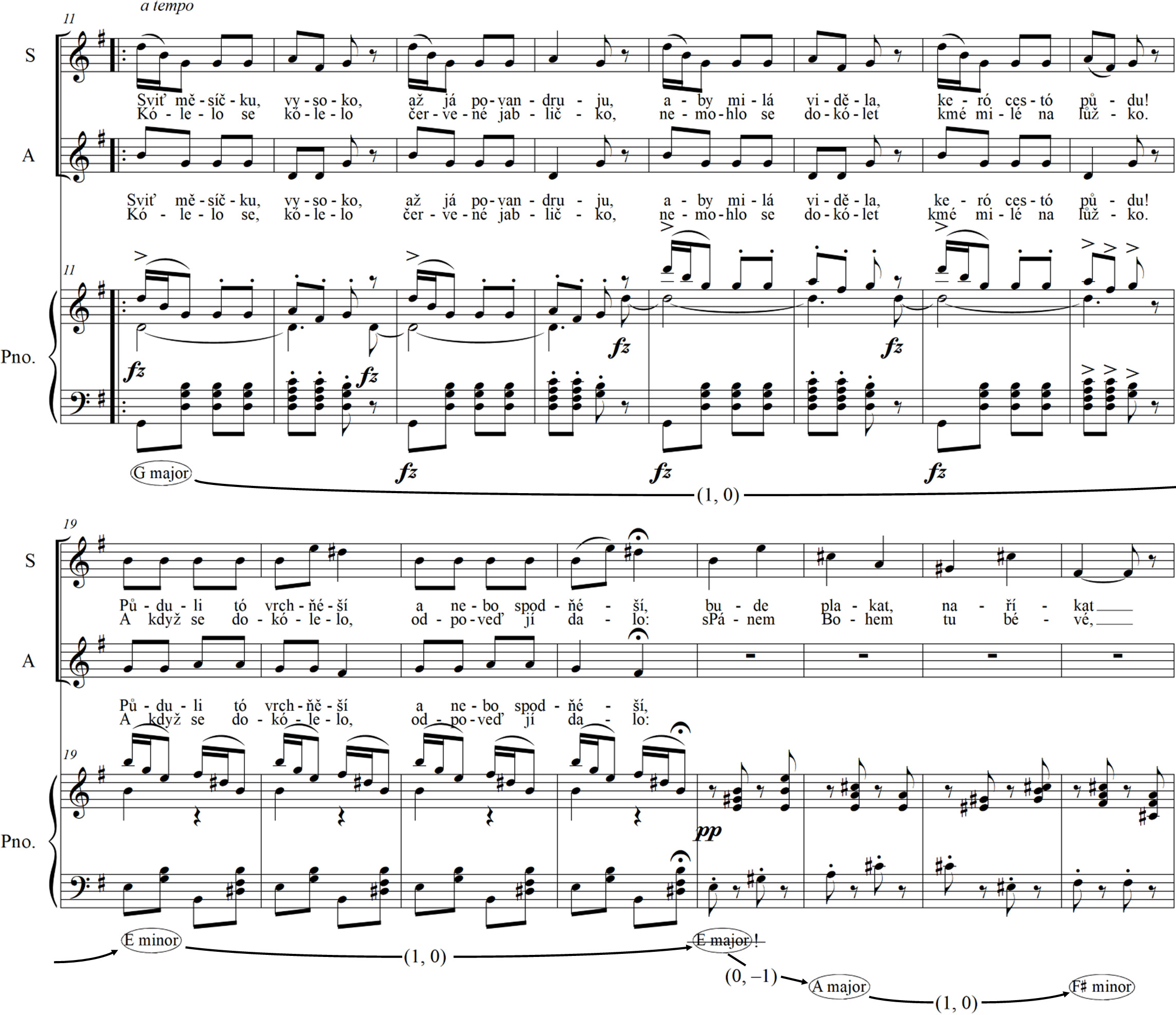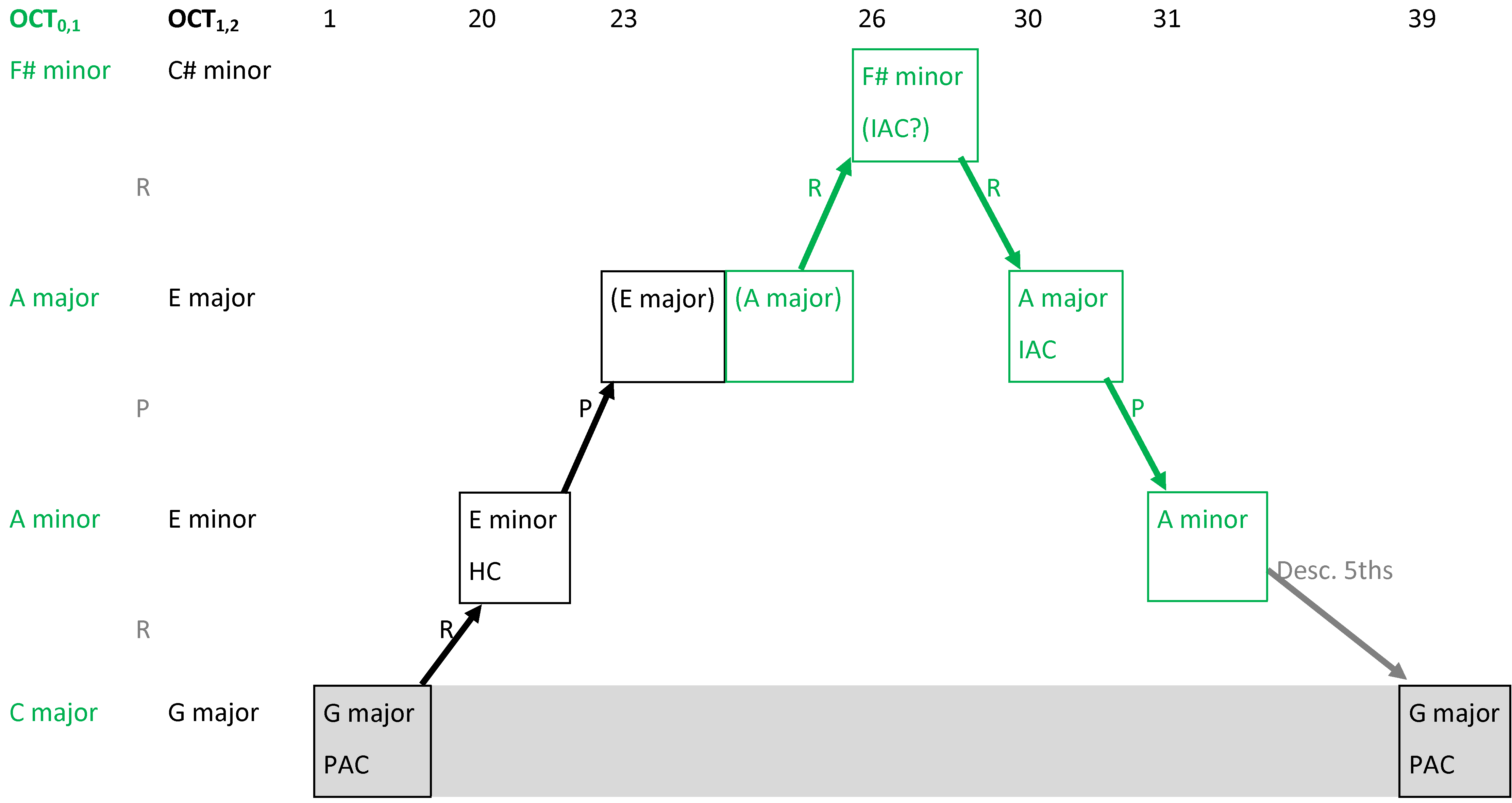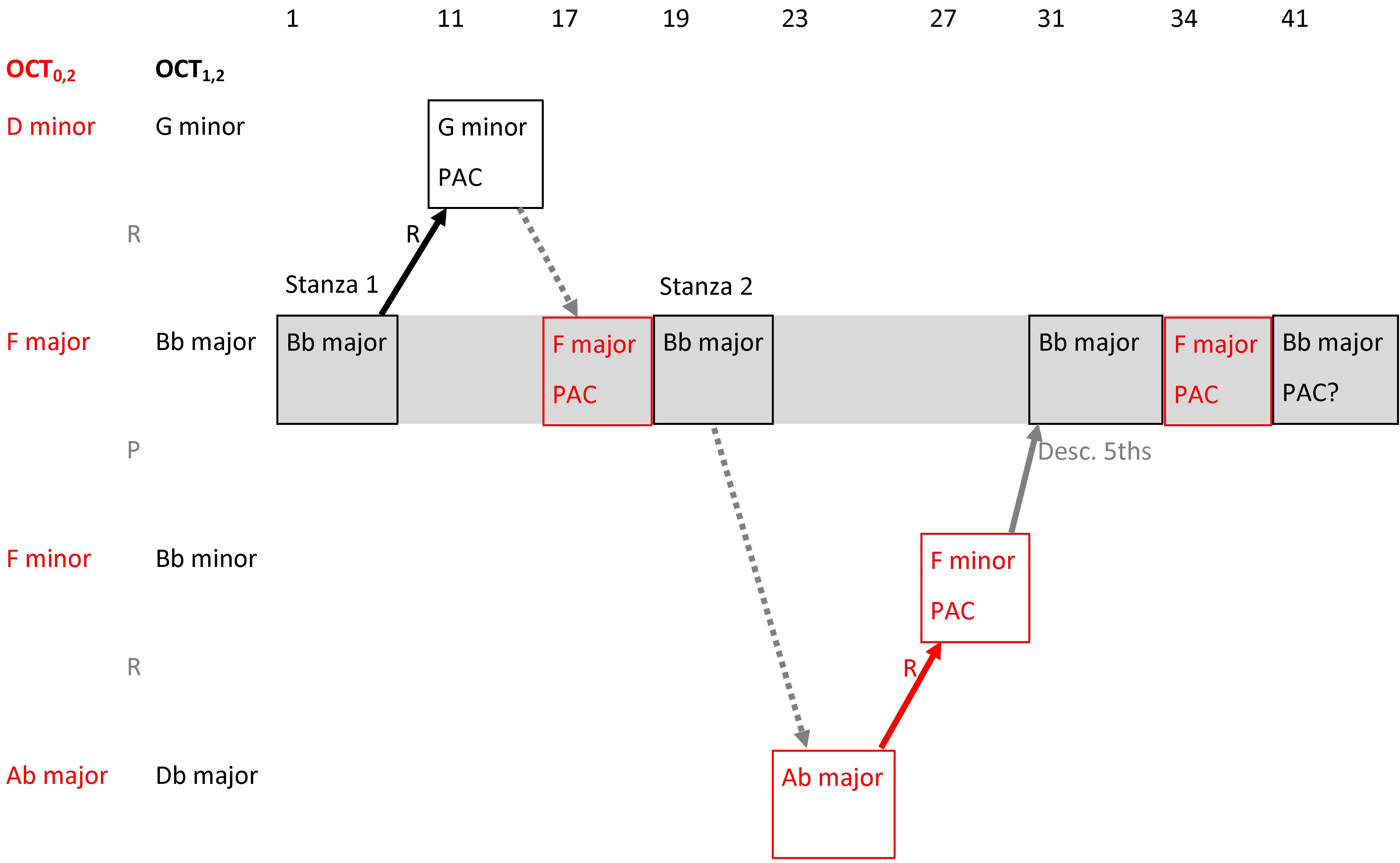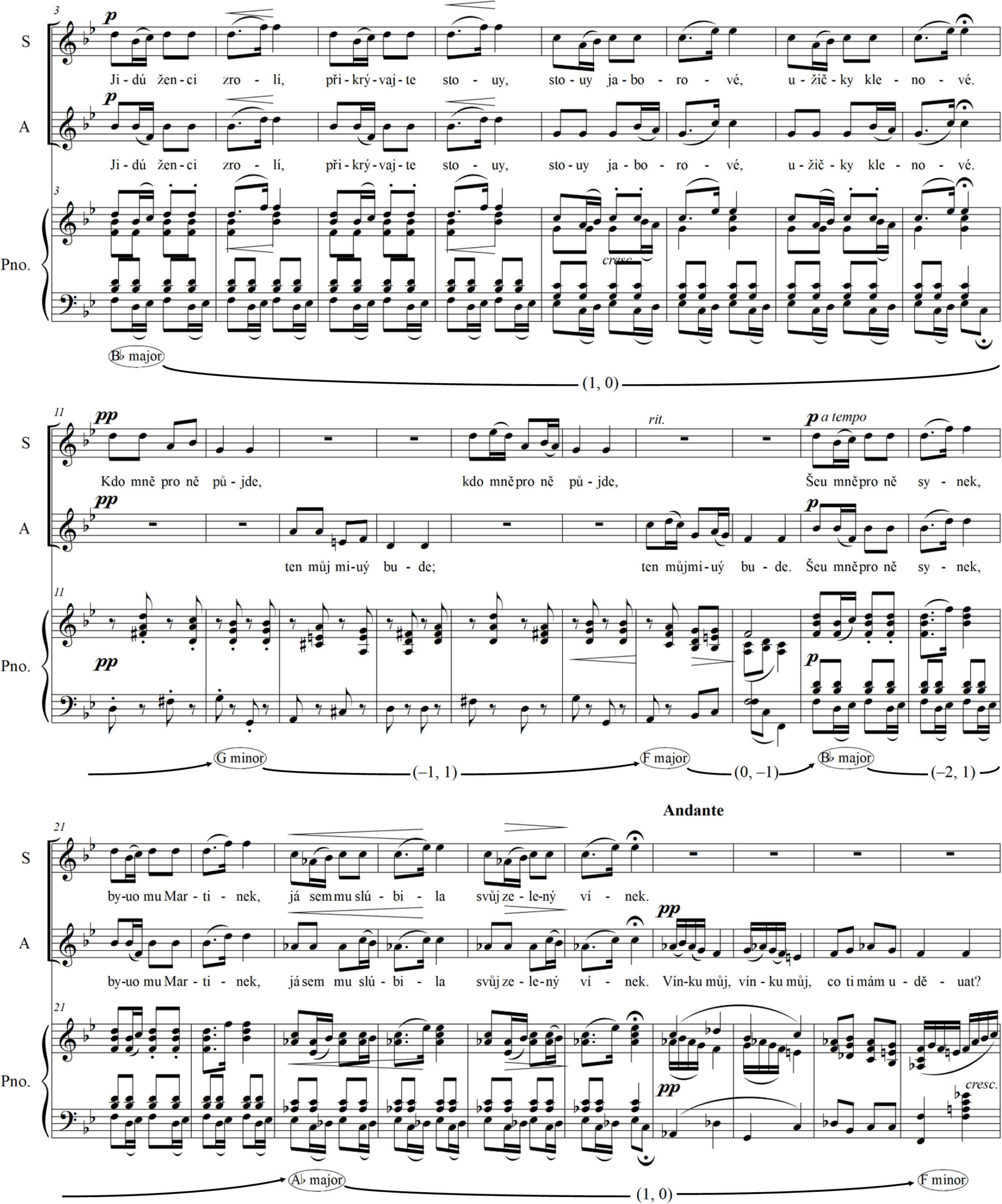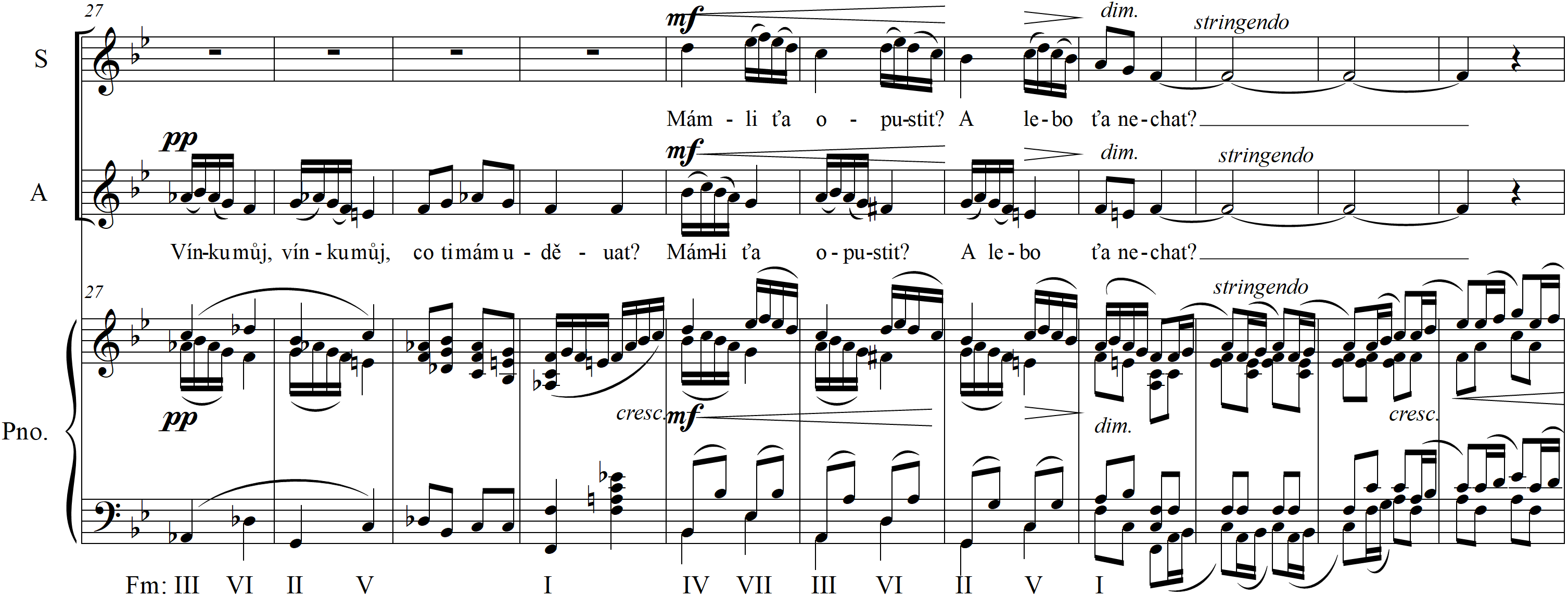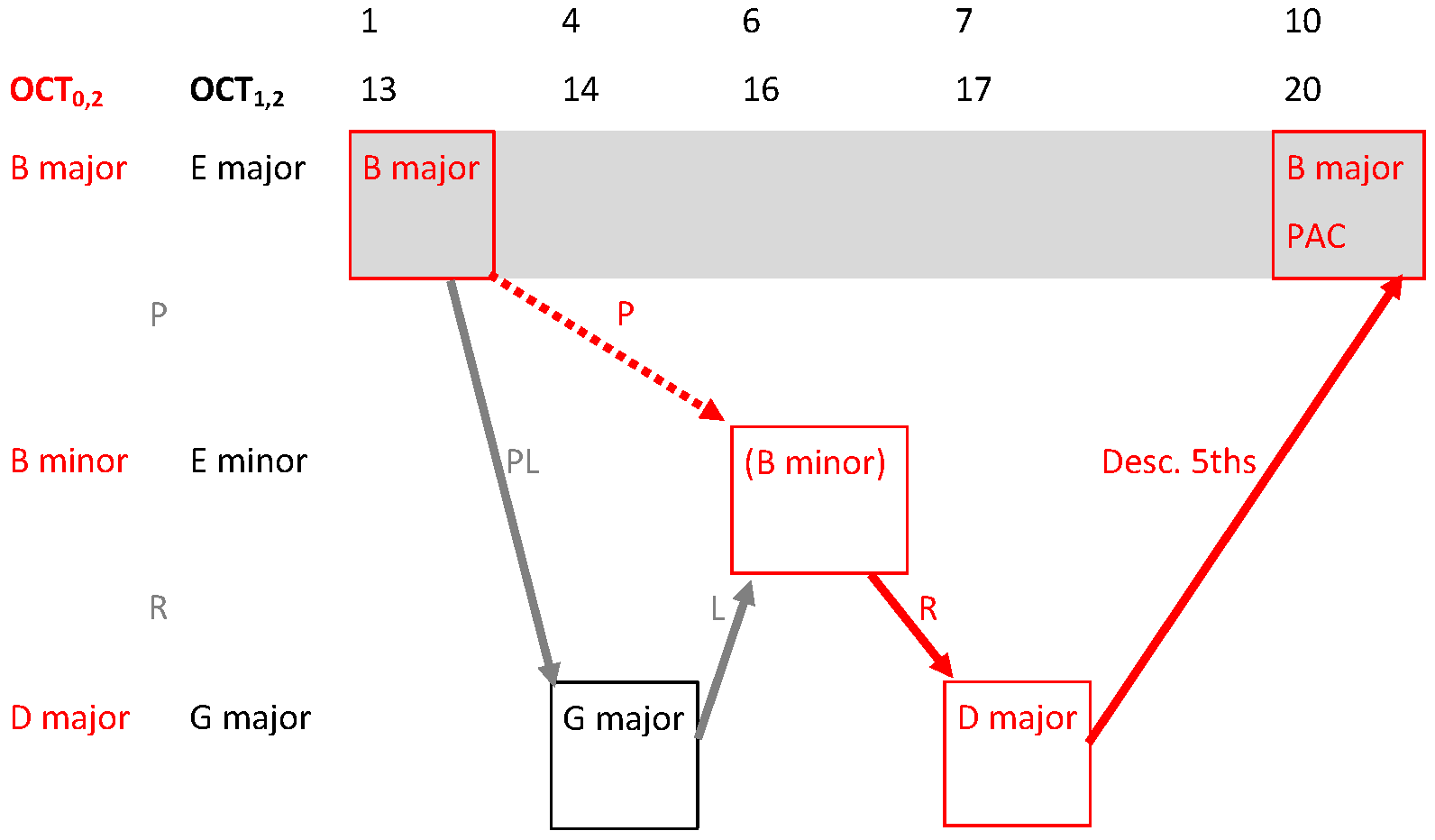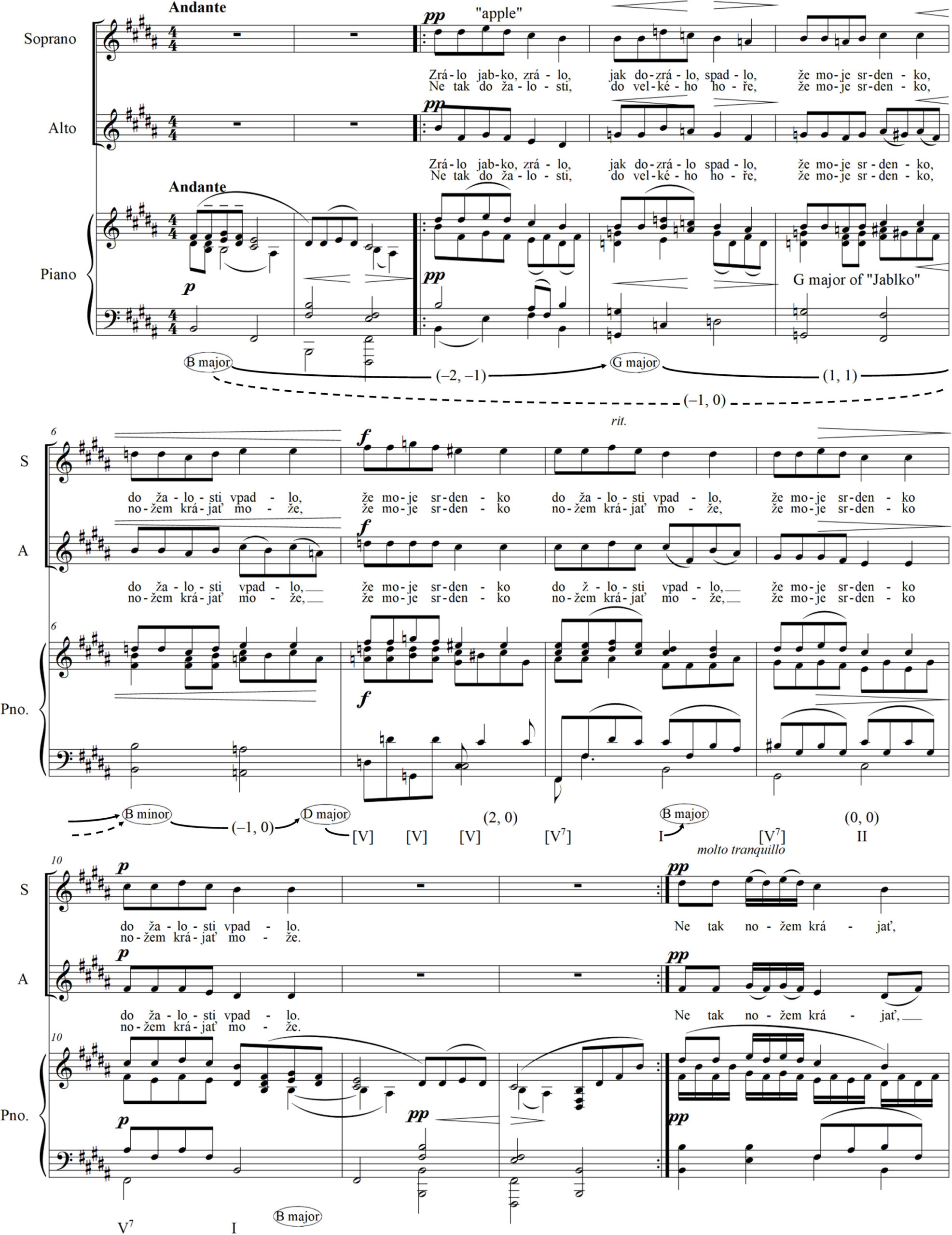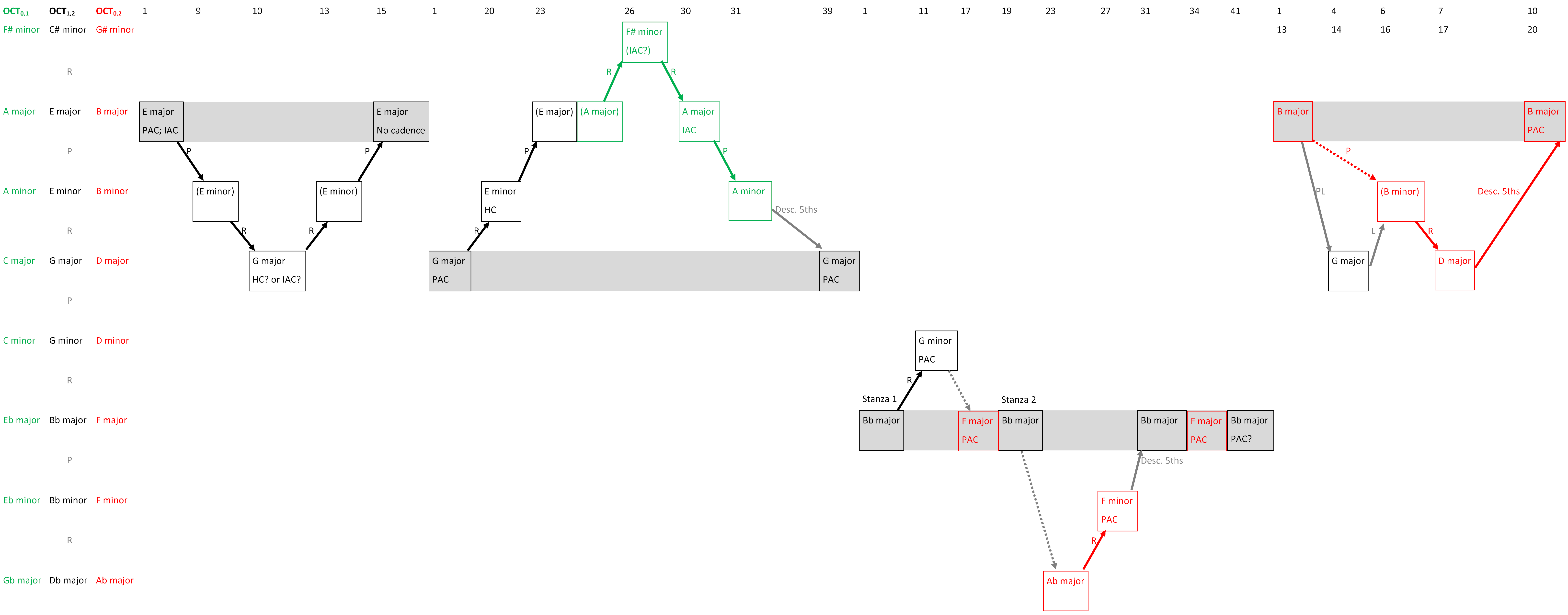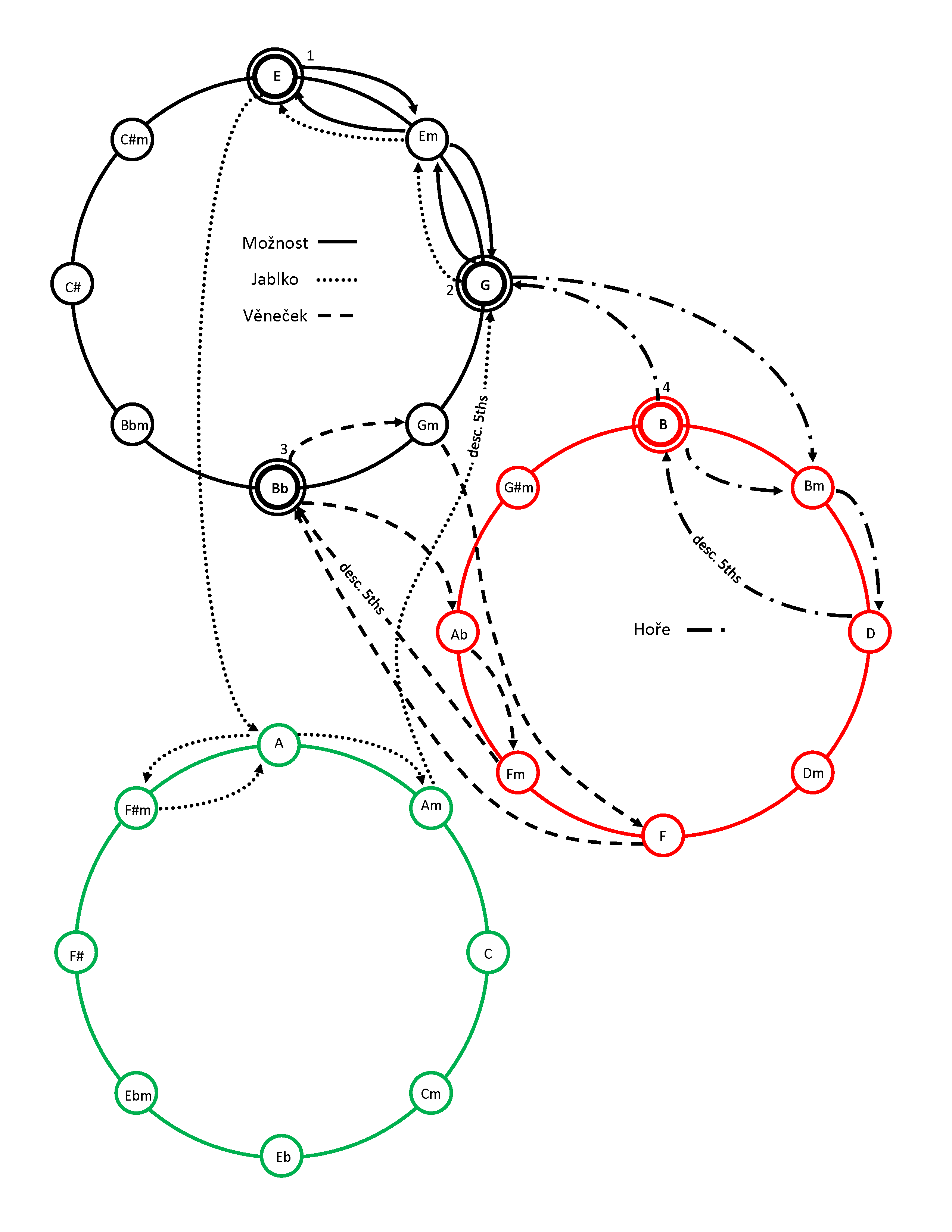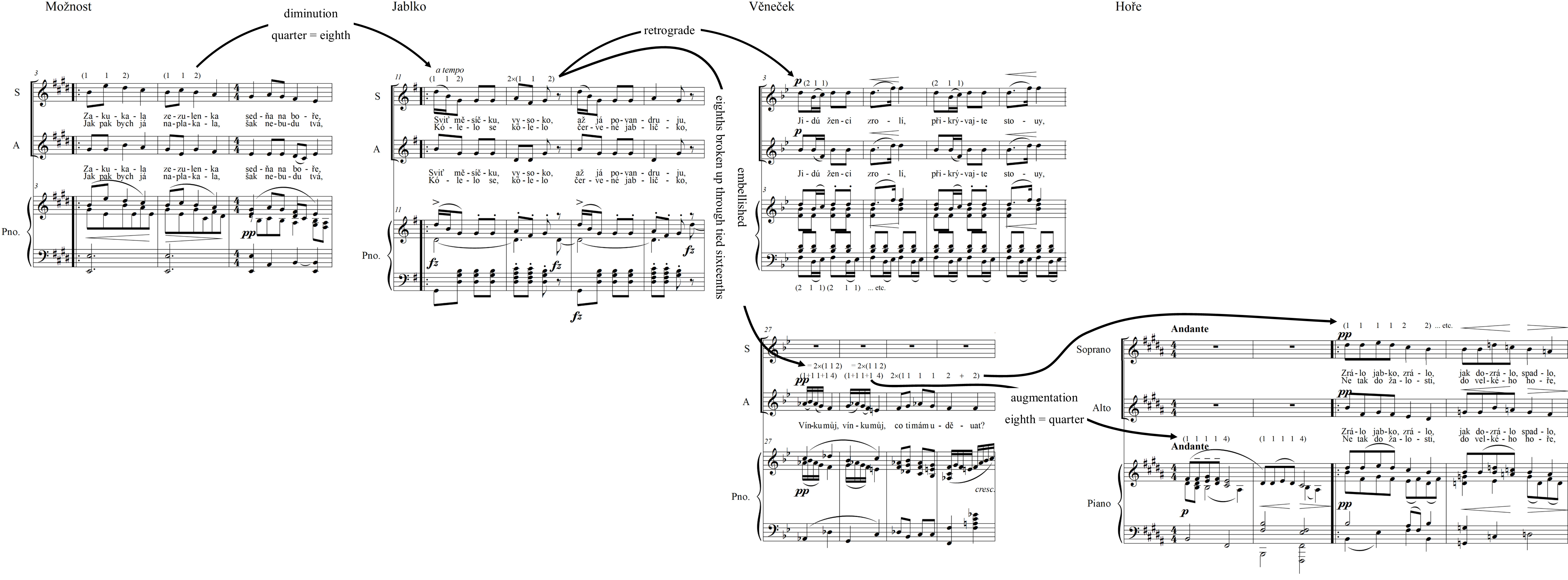Xieyi (Abby) Zhang
Abstract
Despite being considered some of his most pivotal compositions, Dvořák’s Moravian Duets, op. 38, have long been analytically overlooked. The present essay uses neo-Riemannian methods to understand the final set of Dvořák’s Moravian Duets and demonstrates that these parsimonious voice-leading techniques—ones that came to dominate Dvořák’s compositional style—play against descending fifths progressions to create a tragic narrative across the duet cycle.
Keywords and Phrases: Dvořák, neo-Riemannian, nineteenth century, art song, octatonic cycles, narrative, song cycles
Introduction
Antonín Dvořák’s Moravian Duets, opp. 20, 32, and 38, composed between 1875 and 1877, have long been considered some of his most pivotal compositions.1 They earned him recognition by the likes of Johannes Brahms and Fritz Simrock, spurred numerous similar compositions, and ultimately gave him the international recognition to be invited by Jeannette Thurber to the United States, where he composed other iconic works like the “New World” Symphony and the “American” String Quartet.2 Analytical discussions of such formative compositions, however, have been virtually nonexistent in the literature. This neglect might give the impression that, despite their importance to Dvořák’s life, the analytical aspects of the compositions are somewhat uninspired. On the contrary, these duets exhibit a rich and unique musical language that not only enhances the narrative of the song cycles, but also influences much of Dvořák’s later harmonic-compositional style.3
This paper analyzes the third set of Moravian Duets, op. 38 through a neo-Riemannian perspective and sheds light on the narrative implications of these songs. I begin with an overview of the set and devise a formal model for analyzing the main harmonic gestures in the duet cycle. Following this, I analyze each song in order, illuminating a narrative of hope to grief that weaves across the four songs.
1. The Moravian Duets, Op. 38: A Summary
The Moravian Duets, op. 38 are the third and final set of Moravian Duets and the only one to remain unchanged from its original publication. All three sets of duets were commissioned by Jan and Marie Neff and are based on the texts of Moravian folk songs compiled by František Sušil.4 The texts and translations of the four poems are provided in Table 1.5 The textural profile of the four duets remains remarkably consistent throughout. Each duet features the soprano and alto singing homophonically with the piano doubling both voices. The only two moments where this pattern is broken are used to paint the image of separation and loneliness.
| Title | Key | Text | Translation |
| Možnost (Possibility) | E major | Zakukala zezulenka sedňa na boře, zaplakala má panenka choďa po dvoře. Ja co plačeš a nařikáš, dyť ty budeš má, až zezulka na vánoce třkrát zakuká! Jak pak bych já neplakala, šak nebudu tvá, dyť zezulka na vánoce nikdá nekukát! Pán Bůh mocné, Pán Bůh dobré, on to může dát, Že zezulka na vánoce může zakukát! | Calls the cuckoo [the cuckoo calls] sitting on a pine tree, cries my darling [my darling cries] walking about the yard. “Alas, what are you crying about, that you will be mine, as the cuckoo on Christmas three times calls out.” “How would I not weep, since I would not be yours, indeed the cuckoo on Christmas never calls!” “God almighty, God the good, he can provide it, that the cuckoo on Christmas can call.” |
| Jablko (Apple) | G major | Sviť měsíčku, vysoko, až já povandruju, aby milá viděla, keró cestó půdu! Půduli tó vrchňéší a nebo spodňéší, bude plakat, nařikat moja némiléší. Kólelo se, kólelo červené jabličko, nemohlo se dokólet k mé mile na lůžko. A když se dokólelo, odpoved’ jí dalo: s Pánem Bohem tu bévé, moja milá panno. | Shine, moon, high, as far as I wander, so that my dear sees where I am going! I will go, if either by high road or low road, will cry and lament my most loved. [my most loved will cry and lament.] Rolled, rolled, the little red apple, it could not roll to my love in bed. And when it was done rolling, it gave her a response: “with the Lord God here you stay, my beloved.” |
| Věneček (Garland) | B$$\flat$$ major | Jidú ženci z rolí, přikrývajte stoly, stoly jaborové, užičky klenové. Kdo mně pro ně půjde, ten můj milý bude. Šel mně pro ně synek, bylo mu Martinek, já sem mu slúbila svůj zelený vínek. Vinku můj, vínku můj, co ti mám udělat? Mámli ťa opustit? A lebo ťa nechat? Má panenko krásná, nestrhaj mia z jasna, trhaj mia na podzim, až sa já zhotovím! | Ride reapers from the field, cover the tables, maple tables, sycamore legs. Who will go for me to fetch them, that my love will be. My son went for me, he was Martinek, I have promised him my green garland. My garland, my garland, what am I supposed to do with you? Should I forsake you? Give you up? “My darling beautiful, don’t pluck me in the spring, pluck me in the fall, when I’ll be ready.” |
| Hoře (Grief) | B major | Zrálo jabko, zrálo, jak dozrálo, spadlo, že moje srdenko, do žalosti vpadlo. Ne tak do žalosti, do velkého hoře, že moje srdenko, nožem krájať može. Ne tak nožem krájať ale pilú řezať, dyť tebe nemožu, můj synečku, dostať. | Ripened apple, ripened, as it matured, it fell, as my heart fell into mourning. Not just into grief, [but] into great sorrow, that my heart has been cut with a knife. Not just sliced by a knife but cut by a saw, indeed to you I cannot, my son, to get. [indeed I cannot get to you, my son.] |
Harmonically speaking, the duets combine a globally octatonic soundscape realized using neo-Riemannian P and R transformations with a locally diatonic vocabulary generated by functional diatonic harmonies and progressions by fifth.6 Example 1 illustrates the interactions between these two harmonic profiles.7 The three unique octatonic collections parse the collection of keys into three closed tonal cycles, each encompassing a complete set of PR-related triads. Progressions by fifth, on the other hand, are used to traverse between the three collections.
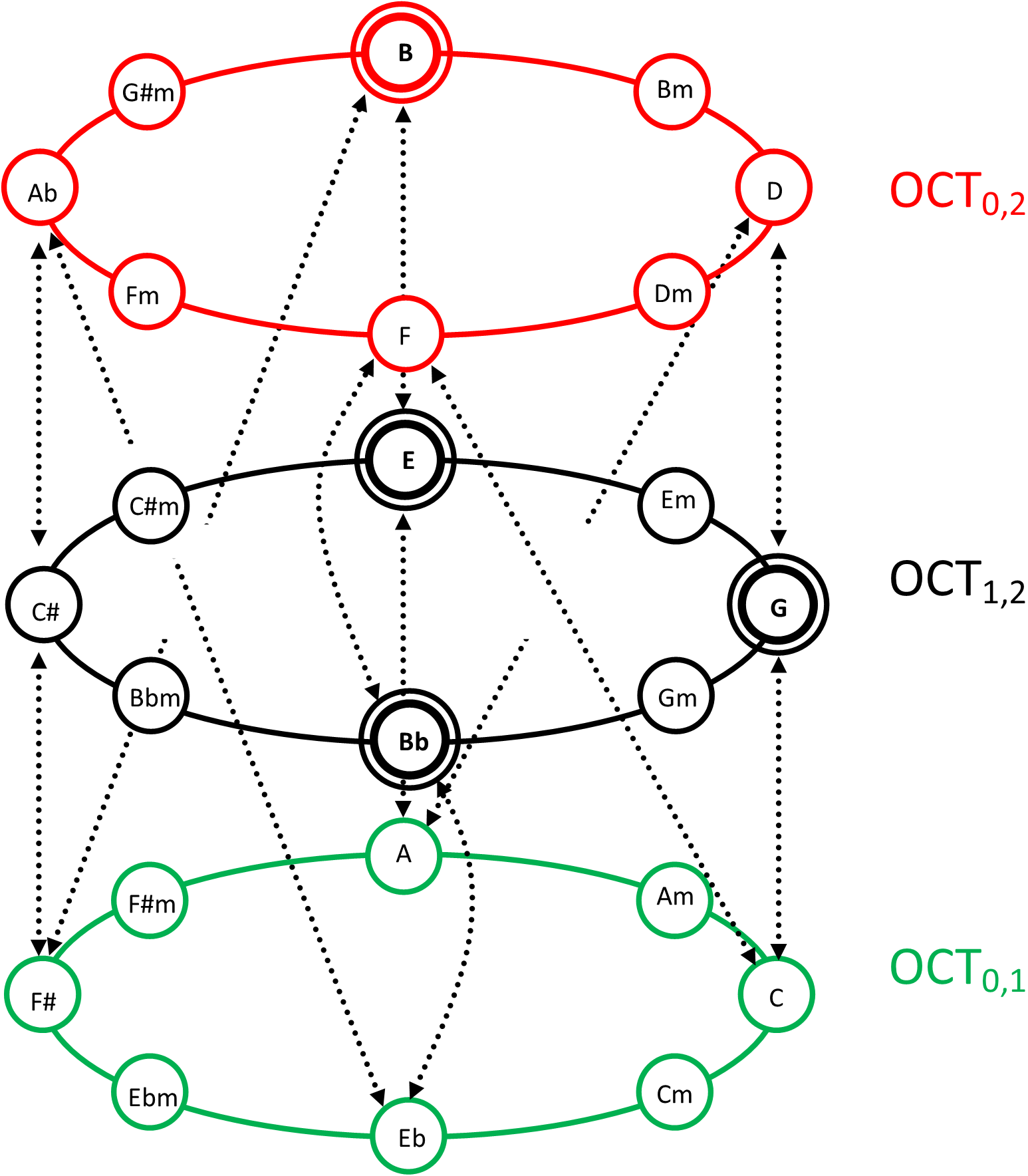
Interactions between PR cycles and descending fifths portray the textual narrative across the duet cycle. As Table 1 demonstrates, the song cycle begins with hope for the narrator to be reunited with the object of her desires. As the song cycle progresses, the protagonist becomes increasingly worried, until hope ultimately dies in the final song. Tonal centers for the first three songs occupy the OCT1,2 PR cycle (or PR1,2).8 Within this cycle, increasing voice-leading distance from the key of the first song represents increasing distance from hope, and the final song begins in PR0,2 to depict the new unattainability of hope. Throughout the duet cycle, PR transformations gradually give way to fifth-related ones. For the most part, PR-related voice-leading supports the hopeful atmosphere established at the outset of the song cycle. The subject of the text then becomes increasingly mournful, and the descending affect of the fifths begins to settle in as the narrator confronts the reality of loss.
2. Harmonic System of the Moravian Duets: Analytical Model and Criteria
The harmonic motions in these duets are most effectively modeled using Julian Hook’s (2002) uniform triadic transformations. Under this model, the set of all chords related by P and R can be generated using <–,9,0> and its inverse, <–,0,3>, whereas those related by fifths are generated through <+,7,7> and <+,5,5>, its inverse.9 Since the two sets of generators function independently from one another, this group of transformations is best modeled using the ordered-pair operations (<–,9,0>a, <+,7,7>b), where $$a \in \mathbb{Z}_8 $$ and $$b \in \mathbb{Z}_{12} $$ represent the number of times each operation is applied. This group of transformations is isomorphic to the direct product group $$\mathbb{Z}_8 \times \mathbb{Z}_{12}$$ represented by (a, b) and can therefore be represented using the latter.10 In other words, using the form (a, b), a represents the number of nodes traveled along the octatonic PR cycle, whereas b indicates the number of fifths traversed.
Example 2 demonstrates the application of this nomenclature using the opening of the second duet. This group of operations contains two immediately relevant subgroups. The subgroup described by the transformations (a, 0) contains the set of all neo-Riemannian P and R transformations, while the subgroup described by (0, b) contains the set of all fifths-related transformations.11
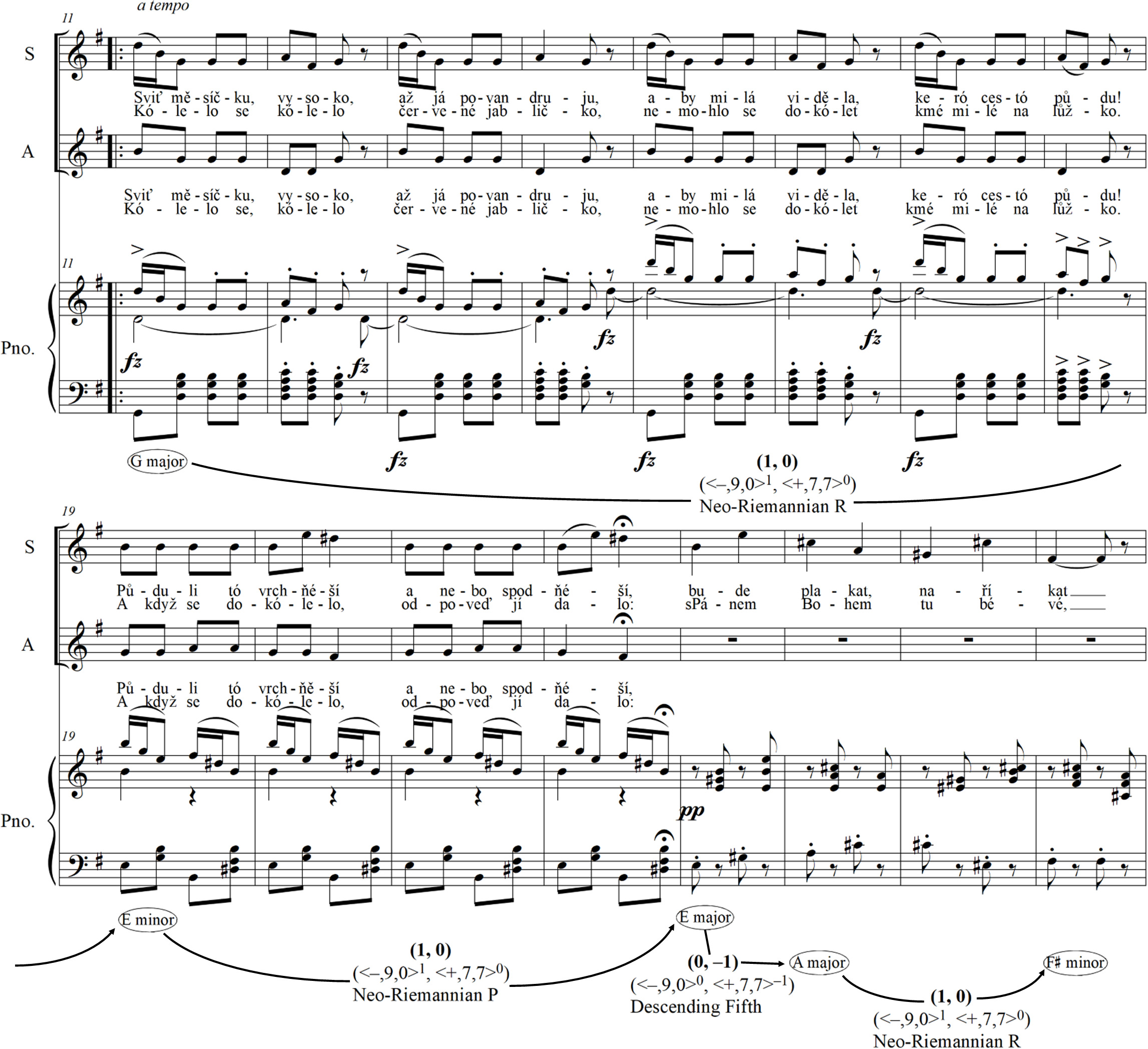
Using this system, we can proceed to analyze the harmonic contents of the duet. This essay will include harmonic areas in the analysis if they receive cadential confirmation, are emphasized through motivic salience or prolonged exposure, and/or are significant passing or neighboring harmonies with a PR or fifths cycle. The first condition confirms the arrival of a key area through cadential progressions. Since Dvořák’s musical style relies on locally diatonic harmonic gestures, these cadences continue to serve as points of arrival in Dvořák’s music.12 The second condition includes harmonies that might not function locally as tonic but are given a level of prominence by carrying an important motivic idea or simply sounding for a significant amount of time (at least two measures). This condition often applies near the beginning of musical phrases. The final condition, a significant passing motion within a PR or fifths cycle, accounts for various harmonies that, while brief and not cadentially confirmed, perform a crucial role in the harmonic profile of each duet by facilitating a link between two adjacent nodes on their respective harmonic cycles. Given the passing nature of this last category, however, they will frequently be shown in parentheses.
All duets follow a similar harmonic-formal layout in which each song travels away from its home key to some climactic turning point—the point farthest removed from the home key—before turning back. Like the home key of each song, these turning points contribute substantially to the narratives depicted in each song. The following analyses trace the songs through these key areas and interpret the narrative suggested by these paths.
3. I: Možnost (Possibility)
As the title suggests, the duets open with hope, as the text likens the cuckoo with the narrator’s hope of being reunited with her beloved.13 This hope is mirrored by both the harmonic and metric features of the duet, in which hope of resolution is always present but never entirely realized. Example 3 provides the score, along with the harmonic transformations that operate across most of the opening song. Example 4 summarizes these relationships both temporally and spatially. Example 4a provides harmonic relationships through time. Each step upward along the vertical axis correlates to a (1, 0) transformation within the PR1, 2 cycle, and each step downward conversely correlates to a (–1, 0) transformation. Example 4b, on the other hand, provides a spatial representation of this progression along a visualized PR1,2 cycle, where a (1, 0) transformation correlates to a counterclockwise move along the diagram.
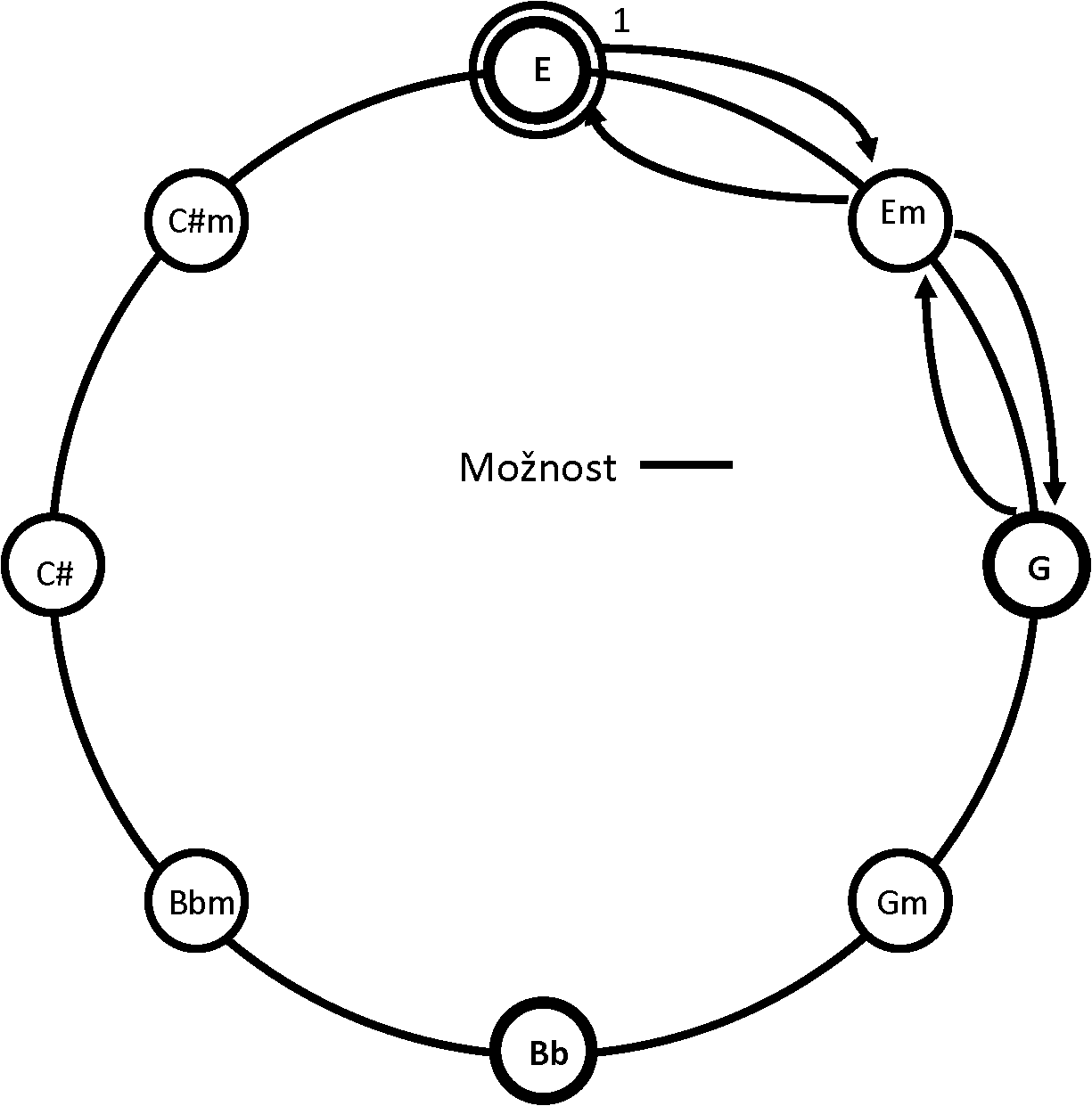
The song can be parsed into two sections that mirror one another. The first section arrives at its climactic turning point, G major, via a PR transformation, while the second moves back to E major using the same transformation in reverse. In this song, the smoothness of the PR transformations are foregrounded through the piano’s voice leading. As Example 5 illustrates, these harmonies maintain close voice leading not only in the abstract sense but also in their explicit voicing on the piano.
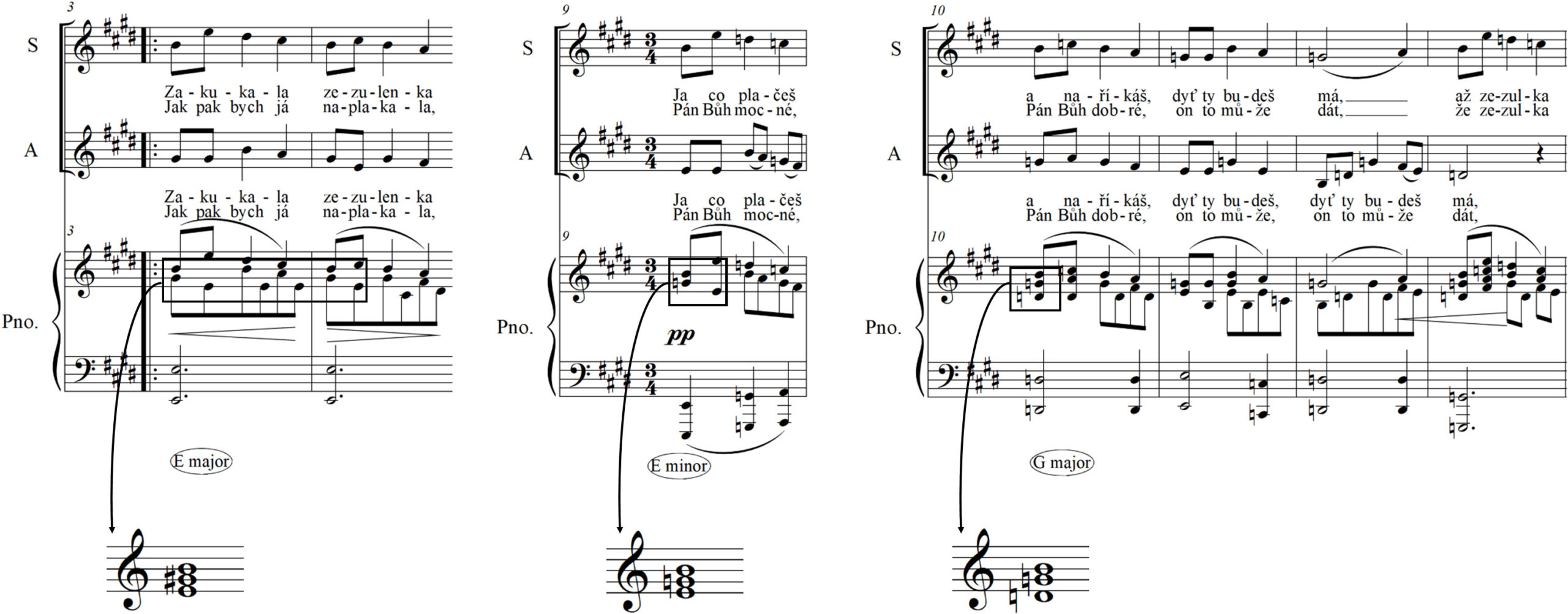
Narratively speaking, these PR transformations depict the presence of hope, although the protagonist must fend off moments of doubt. A two-measure accompaniment opens in E major. The vocalists enter in m. 3 by describing the cuckoo and soon thereafter conclude with what could be understood as a somewhat early PAC in m. 5 (Example 6). The metric placement of this potential PAC is particularly intriguing, as it takes place within the only notated time signature change in the entire collection of duets.14 This sudden change into quadruple time makes it possible to understand this resolution as taking place effectively on a triple-meter downbeat. However, the intentional time change could suggest that care is taken to evade the downbeat resolution. As the title suggests, hope is present, but depending on the interpretation taken, it might be either attained or lost.
The phrase repeats in mm. 6–8, at which point the text establishes a connection between the cuckoo and the object of the narrator’s description. This time, however, a PAC candidate does not materialize; instead, the soprano turns away from $$\hat{1}$$ to conclude the phrase with an IAC. Here, we see a level of doubt settle in the narrator’s mind: she is sure of the cuckoo’s calling, but she is less certain that she will see her love again. The switch to quadruple time at the cadences in mm. 5 and 8 also results in the only two incomplete hypermeasures in a collection replete with four-measure regularity, yet again emphasizing the strangeness of this passage.
Following this opening, the music progresses through E minor in m. 9 to G major in m. 11 (Example 7). At the same moment that the music moves away from E major, the narrator turns from the cuckoo to herself and raises the possibility that her love might not be reunited to her. With this reference to the self, the song associates E major with an idealistic hope and G major, its turning point, with reality.15 Metrically speaking, this cadence is equally suggestive. In m. 12, the soprano and alto lines diverge from one another for the first time, with the soprano concluding on the V of m. 12 and the alto continuing into the I of m. 13. As such, this moment could be heard as either a half cadence or an IAC. For the soprano, authentic cadential arrival on G major never materializes, but is cut off at V. The alto, however, does arrive on I on the unequivocal downbeat that eluded the opening cadences, albeit somewhat beneath the surface. As such, this instance possibly represents a moment in which the narrator rejects G major on the surface by denying its resolution onto I, but the resolution onto tonic underneath reveals that reality has taken hold more than the narrator wants to admit.
Following this ambiguous cadence, the music turns back, through E minor, to the opening key of E major, just as the text returns its focus to the cuckoo. This time, the meter does not change, and the final tonic falls on the downbeat, providing a metrical resolution that has been sought after since the start of the song. This metrical stability, however, is shadowed by an inconclusive harmonic-melodic resolution. Not only does the soprano close with $$\hat{3}$$, but the root-position V is abandoned in m. 15 as the bass steps up to $$\hat{7}$$, producing a weakened IAC. While E major arrives here on a decisive downbeat, the lack of a conclusive cadence signifies that, while hope is remains present, it is not fully secured.
In the end, the hope presented in the text remains only potential. Even though the song concludes on a downbeat in E major at a point where the narrator is talking about the possibility of meeting with her beloved, the weakening of the final cadence denies any clear confirmation of this outcome. If anything, the progressive inconclusiveness of each phrase ending—from the potential PAC of m. 5 to the attenuated IAC of m. 16—foreshadows the unstable nature of this hopeful union.
4. II: Jablko (Apple)
The second song begins in G major, the key that referred to possible separation between the narrator and her love in the previous song. The text now describes the same separation: as much as the apple rolls away, it can never reach her beloved, indicating that this separation involves more than physical distance. The final line of the text reveals the potentially tragic direction to which the text now turns. The narrator’s object is now “with the Lord God,” and no longer alive in the narrator’s world.
This gradual loss of hope is depicted through harmonic means, as this song contains the first of many instances in which the descending fifths (0, –1) progression is used. PR transformations, though prominently featured, are somewhat less foregrounded on the surface. Whereas the opening duet contained parsimonious voice leading in the piano, the voice leading in this duet is limited to an abstract level. Although the voices preserve some semblance of voice-leading parsimony, the piano’s right hand moves relatively strictly by preserving the shape of root-position triads. Example 8 depicts some of these transformations in the opening sections of the score.
Example 9 shows the same two illustrations of the song’s tonal path as before.16 Like the first song, this one can be divided into two sections (mm. 1–26 and mm. 27–51). The duet moves out of PR1,2 and into PR0,1 for most of the song’s second half. The song opens with a piano introduction consisting of descending sixteenth notes, possibly a musical portrayal of a rolling apple. As the vocalists enter, the song attempts to return to E major, the key of “Možnost,” just as the text’s apple tries to roll back to the narrator’s beloved. This attempt prompts a series of (1, 0) transformations, initially into an E-minor HC of m. 22, then to E major in the following measure.
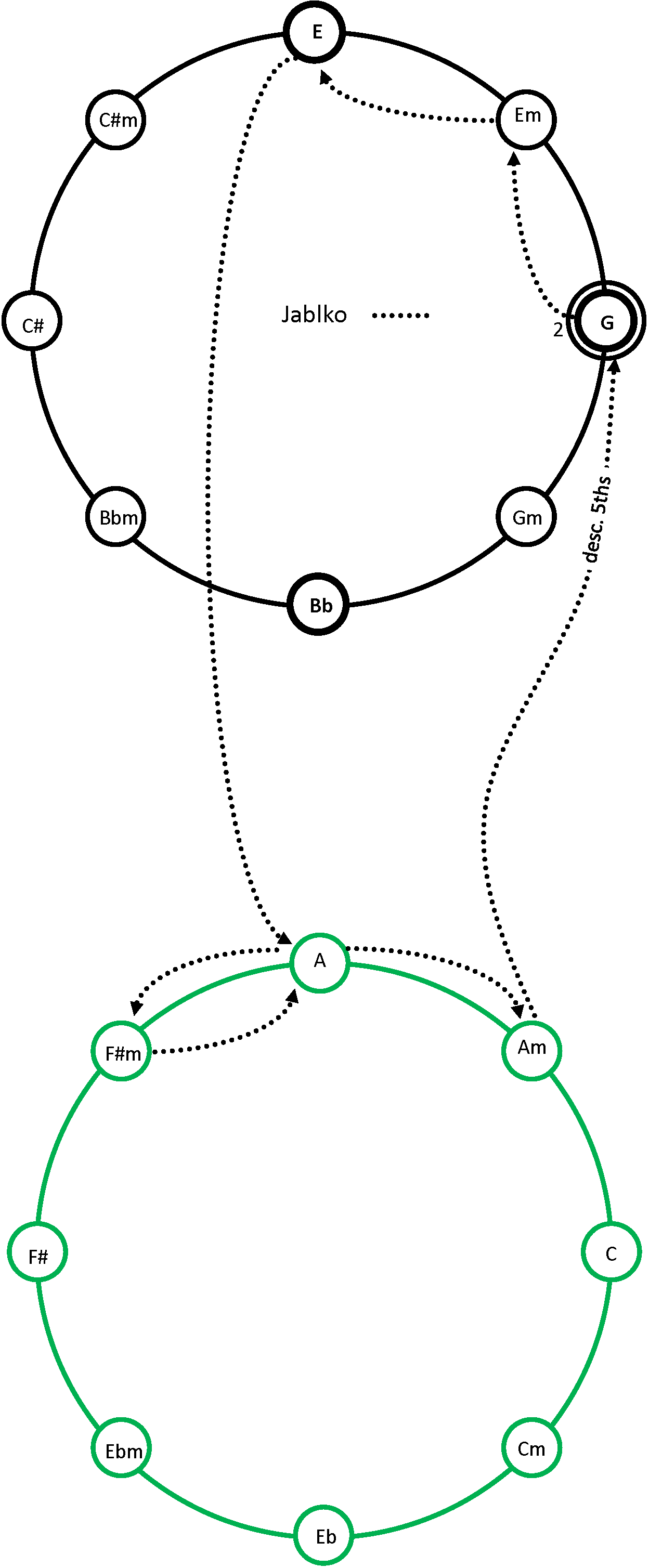
Example 9: Transformational operations and key areas in “Jablko,” illustrating (a) a timeline progression and (b) a progression around the PR cycles.
The arrival onto E major in m. 23 suggests that the goal has just been reached. However, this harmony proves to be only fleeting. As soon as it is reached, the music transforms E major from a tonic to an extremely brief dominant. This functional shift initiates a motion by fifths, or (0, –1), to A major. That the first manifestation of the descending fifth motion in the set is also the first gesture to deny the realization of E major foreshadows later manifestations of harmonic motions along the (0, b) axis. This new harmony moves by (1, 0) to F$$\sharp$$ minor, the song’s point of furthest remove, in m. 26, cueing the onset of the song’s second part. These transformations in the PR0,1 cycle use different harmonies than the outset of this duet, signaling that this new space is somehow otherworldly relative to the narrator’s initial state.
This sense of otherworldliness is reflected by the two worlds of the text. The narrator’s hope is in PR1,2, which contains E major; the object, on the other hand, is “with the Lord God” (in PR0,1) and therefore remains out of reach. The non-overlapping nature of the two cycles indicates the degree of separation between these two characters and supports the text’s descriptions that, no matter how the apple rolls, it is unable to reach the beloved. The song ends in G major by means of a brief but clear descending fifths progression from A minor, highlighting further the (0, –1) gesture that initially thwarted the return to E major.
These harmonic associations are further enhanced by textural changes in this song. The consistent texture of the duet singing with piano doubling fades across the song, indicating the increasing degree of separation between the protagonist and her object. Beginning in m. 15, the piano’s doubling of the melody moves up the octave. By m. 19, the piano doubling ceases entirely. The doubling returns in m. 23, but it is offset by one eighth note. At the same time, the alto drops out completely and, when it reappears in m. 27, the two voices are contrapuntal, rather than homophonic. This increasing tension between the performing forces—the most significant one in the entire cycle—illustrates texturally that the protagonist’s beloved is increasingly out of reach.
5. III: Věneček (Garland)
The third song is in B$$\flat$$ major and continues the same trajectory traversed by the first two songs. The PR motion from the E major of “Možnost” to the G major of “Jablko” is replicated to arrive at the current key. Additionally, B$$\flat$$ major and E major occupy polar opposite ends of PR1,2. As such, the third song heightens the narrative to a climax. In much the same way that each duet contains a small-scale turning point, this duet can itself be understood as a large-scale turning point to the entire cycle, both harmonically and narratively: as the key proceeds to the point furthest removed from E major in PR1,2, the narrator moves to the point furthest removed from her initial state.
Example 10 provides the tonal layout of the song. Unlike “Možnost” and “Jablko,” both of which track a single path away from and back to the home key, “Věneček” contains two stanzas, each tracing a different path away from and back to B$$\flat$$ major. Example 11 shows the transformations operating within the opening measures. The first stanza (mm. 1–18) stays fairly close to the home key, as all three transformations move by no more than one step along either dimension. The second stanza (mm. 19–40) takes a more drastic turn: B$$\flat$$ major immediately undergoes a (–2, 1) transformation—the largest single move in the entire set thus far—into the song’s climactic turning point, A$$\flat$$ major. Following this, an R transformation produces F minor. A descending fifths sequence modulates back to the home key, yet again highlighting the growing prominence of the (0, b) progressions.
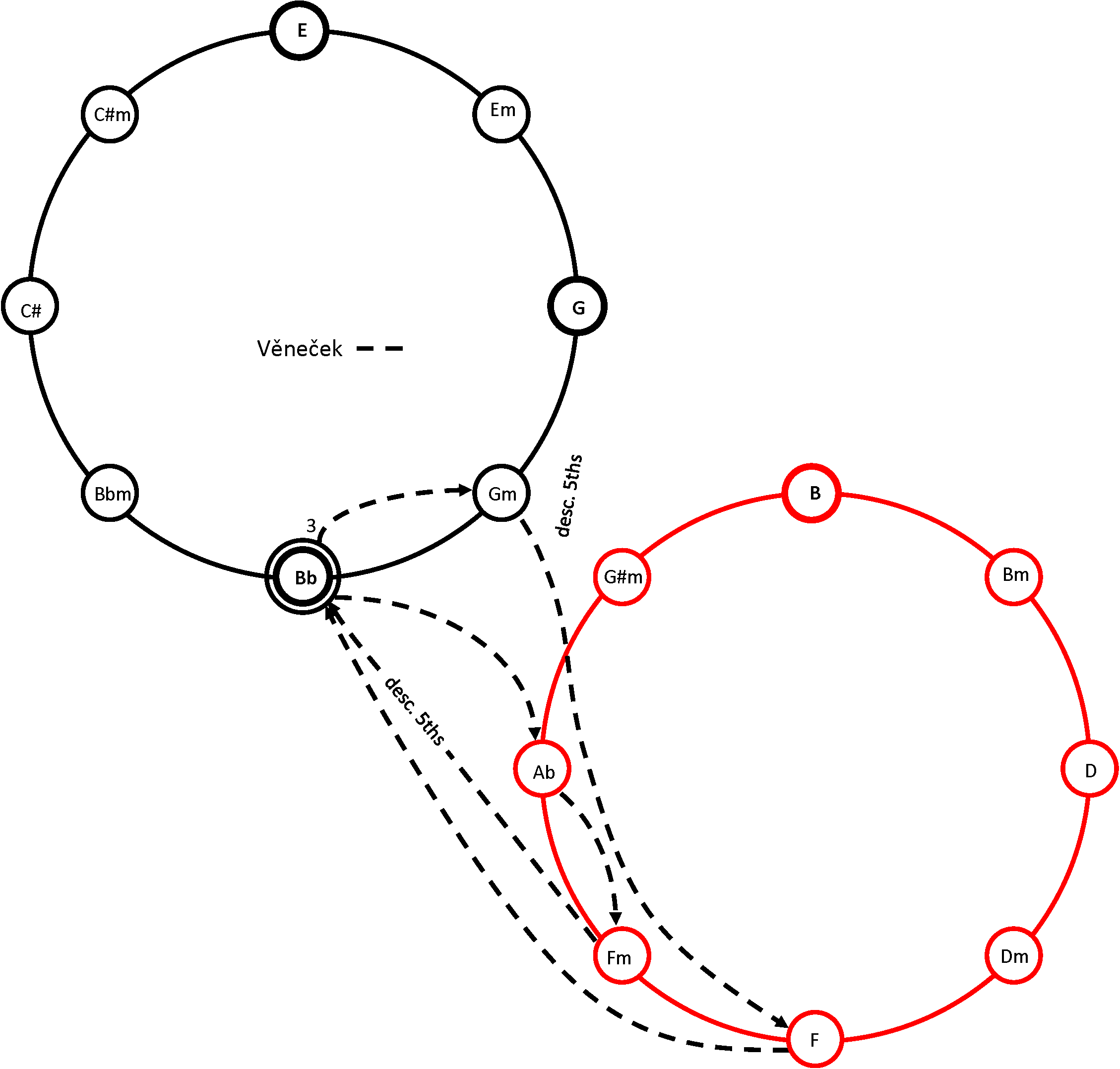
Example 10: Transformational operations and key areas in “Věneček,” illustrating (a) a timeline progression and (b) a progression around the PR cycles.
The text of this song sets up a metaphor between reapers harvesting in the field and death. Although at first the main image centers around harvesting, its context within the song cycle points toward the latter. The narrator reflects on someone named Martinek, the narrator’s son and the “beloved” that has been referred to, who goes to greet the reapers. In the second stanza, the narrator shifts from a reflexive address to a direct one, marked by the introduction of second-person pronouns. However, the recipient of the address is not Martinek, but rather, a garland that she has promised to him, which she describes as being plucked prematurely. Martinek’s name does not appear once in this section. Addressing the garland simultaneously generates intimacy and distance: the narrator is directly speaking to another, but that other is only a substitute for a person the listener was just introduced to. This, along with the use of past tense throughout and the context established by the previous songs, indicates the premature death of the protagonist’s beloved. The protagonist, unable to address the deceased Martinek, and possibly unwilling to confront the reality of Martinek’s death, speaks only to a garland, both as a makeshift object of address, and also to mollify the pain from having to accept his passing.
Martinek’s passing is hinted at musically in several ways. The first and most telling is that, in mm. 11–18, when the protagonist speaks of her love returning, the texture is reduced to solo voices and, much like in the previous song, the melody is not doubled in the piano, once again implying distance between the narrator and her beloved.17 Additionally, the location of B$$\flat$$ major as the polar opposite key from E major in PR1,2 corroborates this narrative. In the second strophe, the turn to A$$\flat$$ major and F minor in mm. 23ff. casts the tonal trajectory of the song even further afield, now into PR0,2. Much like in “Jablko,” the song is thrown into foreign space.
The tension between PR and fifth-related transformations is further heightened in this duet. As Example 10 demonstrates, aside from the two R transformations in mm. 11 and 30, practically all remaining motions are by fifth or by step, with an emphasis on the former.18 The most prominent instances of these progressions by fifth are shown in Example 12. The change from neo-Riemannian transformations to fifth-related chains highlights the latter’s distinct harmonic profile, thereby sonically embodying Martinek’s otherworldly position. Alternatively, the fifths represent a transcendence into another world, since descending fifths are a primary way of transcending the closed octatonic regions created by the PR cycles.19 The switch to descending fifths chains illustrates the new path required to exit the narrator’s PR1,2 world and reach the beloved (in PR0,2).
6. IV: Hoře (Grief)
The final song provides the tragic ending to the duet cycle. Given that the previous song already occupied B$$\flat$$ major, the key furthest removed from E major within the PR1,2 cycle, this song does not continue along the same PR trajectory to D$$\flat$$ major, as any path along PR1,2 would only bring the key closer to E major. Instead, this final song is set in B major, a member of PR0,2—the region occupied by much of the third song. In a sense, this key change reflects the grief that the title describes. The narrator now realizes that she is unable to reach her beloved, much like the opening E major is unreachable by PR transformations from the current key.
Despite this foreignness, this new key is closer to the opening than either of the previous ones. Although no (a, 0) transformation can return to E major, B major is only a fifth away from E major and, as such, one only needs (0, –1) to return to the home key. However, the protagonist either does not sense this close connection or she refuses to concede by succumbing to fifths motions to return. Even though the latter half of each strophe concludes with a prominent descending fifths progression, it cuts off one step short, landing only on B.
Example 13 provides the progression of keys visited in the song, and Example 14 gives the opening two strophes of its three-strophic form. Each strophe contains two sections, demonstrating remarkable formal and harmonic similarities to the opening song. The first section traces the same PR transformation heard in “Možnost” into the climactic moment, while the second returns to the home key to close the cycle. This time, however, the return replaces the parsimonious voice leading with descending fifths.
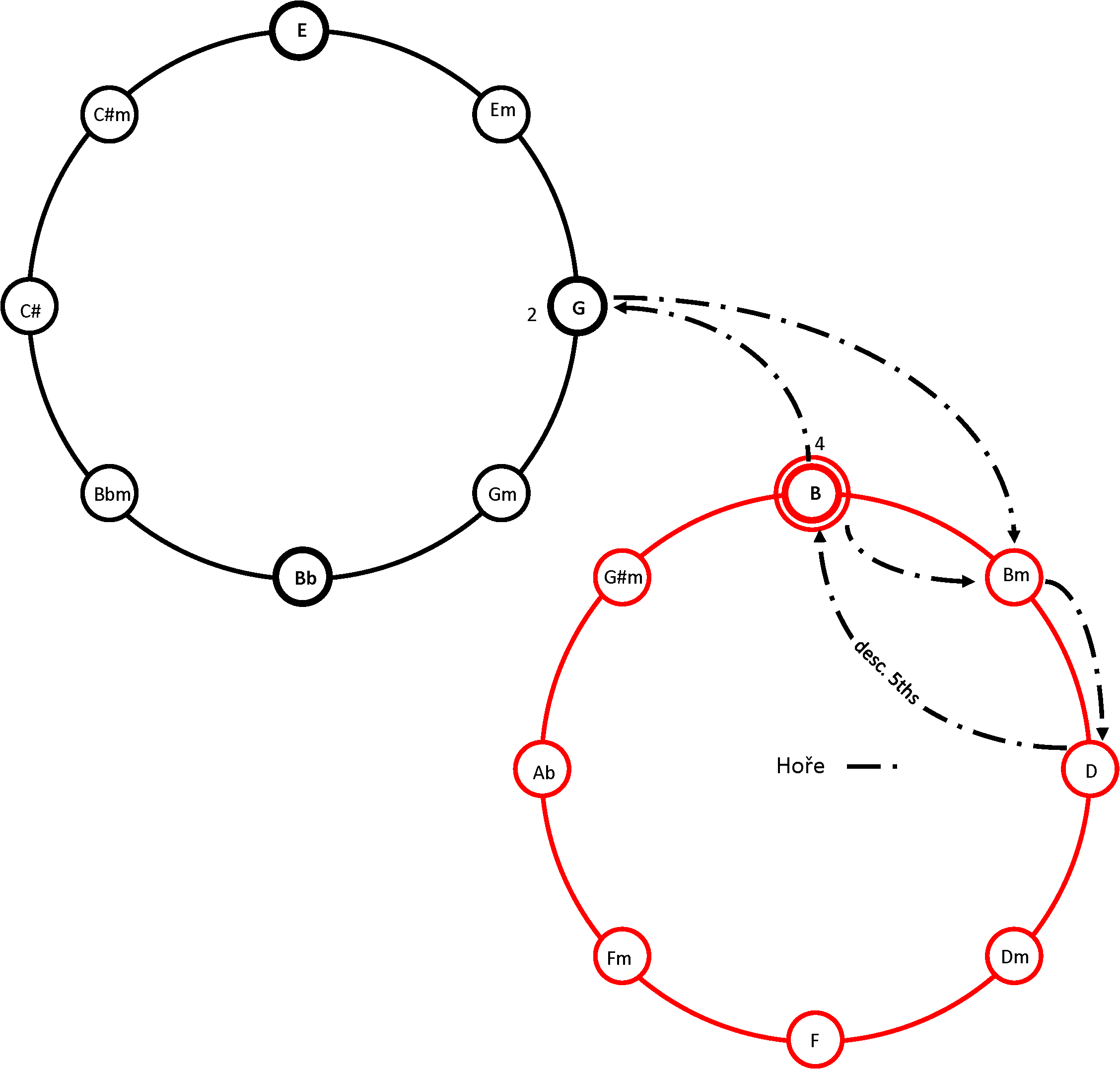
Example 13: Transformational operations and key areas in “Hoře,” illustrating (a) a timeline progression and (b) a progression around the PR cycles.
The duet moves relatively quickly to G major by m. 4. Although this is a typical PL transformation, its sole appearance in the duet cycles thus far nevertheless makes it a striking gesture. This transformation temporarily moves us back to the turning point of “Možnost” and the home key of “Jablko,” likely mimicking the text’s references to the apple. Shortly thereafter, it proceeds to the key of B minor in m. 16 and then D major in m. 17, also the turning point of the song. This song traces the same motions as “Možnost,” recalling the initial descent out of hope. Unlike in “Možnost,” however, the reality in which the protagonist finds herself is now far starker, just as the surface-level voice leading is no longer parsimonious as it was in the opening duet. Even though the motion from B major in m. 1 to D major in m. 17 is a neo-Riemannian PR, the chords now move in parallel motion with their roots rather than surface-level parsimony.
Whereas the second part of “Možnost” returns to the original key by reversing its initial PR transformation, “Hoře” launches into a descending fifths sequence to complete the return to B major. The gesture that initially thwarted a return to E major in “Jablko” now dominates the final song. Furthermore, this motion by chromatic fifths supports a nearly complete lament tetrachord in the melody, musically depicting the protagonist’s mourning. In the end, the narrator stops in B major by m. 8—just one step short of E major—on a melodically incomplete IAC.20 Unlike the first song, in which the vocal melody stopped on $$\hat{3}$$, the sequence is reattempted in the following two measures, this time arriving on a PAC in B major, closing out the song cycle remarkably close to, but ultimately separated from, the key of the opening song.
7. Concluding Thoughts: Cyclical Elements of Hope and Grief
Examples 15 and 16 provide two illustrations of the paths through all four songs. While Example 15 illustrates more effectively the motions to and from each movement’s respective home keys as each song unfolds, Example 16 emphasizes each song’s octatonic-spatial location through the three PR cycles and demonstrates the separation between each of the songs in the song cycle.
To be sure, the work undertaken in the present study by no means exhausts the many possible avenues for investigation in these duets, such as rhythm and meter. While the hypermetrical profile of the duets remains quadruple, with the exception of the evaded downbeats in “Možnost,” piano interludes almost invariably contain only two measures—or half a hypermeasure—of content. This subtle disruption of the work’s otherwise consistent hypermetrical profile indicates some level of subsurface tension in an otherwise unobtrusive hypermetrical grid. Second, the work appears to feature a level of narrative communicated by the surface-level rhythm as demonstrated in Example 17. This involvement of the rhythmic domain further illustrates the potential for rhythm to play a bigger role in advancing this narrative than what was addressed in this essay.
Although the narrative appears to indicate a linear path from the start of “Možnost” to its conclusion in “Hoře,” the duets nevertheless offer several cyclical elements. The most prominent of these cyclical features is that “Hoře” concludes the cycle remarkably close to the opening key. This distance of (0, 1) from the opening key hints that, despite all of the modulations both within and between songs, the final key is not so far off from where the duet cycle began, and that perhaps the end is not quite as hopeless as the narrator believes. While the protagonist appears convinced that hope is irredeemably lost, the closeness of the final key to where we began suggests that we may be closer to the opening than we dared imagine.
References
Adams, David. 2003. The Song and Duet Texts of Antonín Dvořák. Geneseo, NY: Leyerle Publications.
BaileyShea, Matthew. 2021. Lines and Lyrics: An Introduction to Poetry and Song. New Haven: Yale University Press.
Bazayev, Inessa. 2018. “An Octatonic History of Prokoviev’s Compositional Oeuvre.” Music Theory Online, 24 (2). Accessed 27 Feb. 2023. https://mtosmt.org/issues/mto.18.24.2/mto.18.24.2.bazayev.html.
Beckerman, Michael. 2003. New Worlds of Dvořák: Searching in America for the Composer’s Inner Life. New York: W.W. Norton & Company.
Beveridge, David. 1980. “Romantic Ideas in a Classical Frame: The Sonata Forms of Dvořák.” PhD diss., University of California, Berkeley.
Blättler, Damian. 2022. “Ravel’s Octatonic Scripts.” Music Theory Spectrum, 44 (2): 276–303.
Bulíř, Michal. 1990. “Dvořákovy první kontakty s Moravou. [Dvořák’s first contacts with Moravia.]” Opus Musicum, 22 (9): 278–283.
Burger, Arthur. 1968. “Problems of Pitch Organization in Stravinsky.” In Perspectives on Schoenberg and Stravinsky. Edited by Benjamin Boretz and Edward T. Cone. 123–154. Princeton: Princeton University Press. Originally published 1963 in Perspectives of New Music, 2 (1): 11–42.
Černý, Miroslav. 2007. “Antonín Dvořák und die Sonatenform. [Antonín Dvořák and the Sonata Form.]” In The Work of Antonín Dvořák (1841–1904): Aspects of Composition, Problems of Editing, Reception: Proceedings of the International Musicological Conference, Prague, September 8–11, 2004. Edited by Jarmila Gabrielová and Jan Kachlík, 41–51. Prague: Institute of Ethnology, Academy of Sciences of the Czech Republic.
Chandler, Oliver. 2020. “‘Octatonic’ Voice Leading and Diatonic Function in the Allegro molto from Elgar’s String Quartet in E minor, op. 83.” Music Theory Online, 26 (1). Accessed 27 Feb. 2023. https://mtosmt.org/issues/mto.20.26.1/mto.20.26.1.chandler.html.
Cohn, Richard. 1991. “Bartók’s Octatonic Strategies: A Motivic Approach.” Journal of the American Musicological Society, 44 (2): 279–297.
———. 1999. “As Wonderful as Star Clusters: Instruments for Gazing at Tonality in Schubert.” 19th-Century Music, 22 (3): 213–232.
———. 2012. Audacious Euphony: Chromatic Harmony and the Triad’s Second Nature. New York: Oxford University Press.
Döge, Klaus. 2001. “Dvořák, Antonín (Leopold).” Oxford Music Online. Accessed 15 Feb. 2022. https://www.oxfordmusiconline.com/grovemusic/view/10.1093/gmo/9781561592630.001.0001/omo-9781561592630-e-0000051222.
Douthett, Jack, and Peter Steinbach. 1998. “Parsimonious Graphs: A Study in Parsimony, Contextual Transformations, and Modes of Limited Transposition.” Journal of Music Theory, 42 (2): 241–264.
Dummit, David, and Richard Foote. 2003. Abstract Algebra, 3 ed. Hoboken: John Wiley and Sons, Inc.
Forte, Allen. 1991. “Debussy and the Octatonic.” Music Analysis, 10 (1/2): 125–169.
Hook, Julian. 2002. “Uniform Triadic Transformations.” Journal of Music Theory, 46 (1): 57–126.
Kahan, Sylvia. 2005. “‘Rien de la tonalite usuelle’: Edmond de Polignac and the Octatonic Scale in Nineteenth-Century France.” 19th-Century Music, 29 (2): 97–120.
Plotkin, Richard. 2019. “Chord Proximity, Parsimony, and Analysis with Filtered Point-Symmetry.” Music Theory Online, 25 (2). Accessed 27 Feb. 2023. https://mtosmt.org/issues/mto.19.25.2/mto.19.25.2.plotkin.html.
Smith, Peter H. 2020. “Dvořák and Subordinate Theme Closure: ‘Positive’ Analytic Results for a ‘Negative’ Approach to Romantic Form.” Journal of Music Theory, 64 (2): 203–240.
Šourek, Otakar. 2004. “Moravian Duets.” In Antonín Dvořák, Moravian Duets, Op. 20, 32, 38: Critical edition based on the composer’s manuscript. Edited by Otakar Šourek et al, X–XII. Bärenreiter Praha.
Taruskin, Richard. 2011. “Catching Up with Rimsky-Korsakov.” Music Theory Spectrum, 33 (2): 169–185.
Taylor, Benedict. 2010. “Modal Four-Note Pitch Collections in the Music of Dvořák’s American Period.” Music Theory Spectrum, 32 (1): 44–59.
Volek, Jaroslav. 1984. “Tektonické ambivalence v symphoniích Antonína Dvořáka. [Tectonic ambivalence in the symphonies of Antonín Dvořák.]” Hudební Věda 1, 21: 3–31.
Zhang, Xieyi (Abby). 2022. “Apparently Imperfect: On the Analytical Issues of the IAC.” Music Theory Spectrum, 44 (2): 191–212.ta
Notes
- On the history of Dvořák’s Moravian Duets, see Döge (2001) and Šourek (2004).
- One of the primary motivations for Dvořák’s invitation to the United States was to build up American music. On this issue, Thurber invited Dvořák because he had been “so successful in taking Bohemian music into the mainstream” (Beckerman 2003, 4).
- For example, Dvořák’s use of frequent modulations is a trait seen in these duets. For more on these modulations in his symphonies, see Jaroslav Volek (1984).
- On Dvořák’s interactions with and relationship to Moravia, see Bulíř (1990).
- Translations are mostly my own, with occasional consultation against that in Adams (2003). Given the poetic nature of the original text, I opt here for a literal translation that preserves the ordering of words. However, in places where the meaning is obscured by the literal translation, I provide an idiomatic translation in square brackets.
- The relationship between octatonic collections and neo-Riemannian PR cycles has most explicitly been described by Plotkin (2019, [3.1.4]). Several recent authors have noted on the role of octatonicism in works by early twentieth century composers such as Edward Elgar (Chandler 2020), Sergei Prokofiev (Bazayev 2018), and Maurice Ravel (Blättler 2022). These entries add to the use of octatonicism by composers such as Igor Stravinsky (Burger 1968), Claude Debussy (Forte 1991), and Béla Bartók (Cohn 1991). The earliest composer thus far whose music has been analyzed as octatonic is Nikolai Rimsky-Korsakov. Both Sylvia Kahan (2005) and Richard Taruskin (2011) have described the role of the octatonic in Rimsky-Korsakov’s music.
- These duets are, generally speaking, globally octatonic while remaining locally diatonic, much like Richard Cohn’s (2012, 195–199) observations of double syntax in the music of Schubert. As such, the present analysis will couple neo-Riemannian P and R transformations with surface-level diatonic features such as cadences. Example 1, for instance, draws heavily from Cohn’s (1999) star-cluster analyses of Schubert’s work.
- Given the interchangeability of the OCT collections and their generated PR cycles, the rest of this essay will refer to PR cycles generated by their respective OCTx,y collections as PRx,y. For example, the PR cycle contained within OCT1,2 will be referred to as the PR1,2 cycle.
- The labeling of the PR cycle’s generator as a single transformation is based on Hook’s (2002, 89–92) description of the same. It offers the advantage of highlighting the cyclical nature of the transformations even if it sacrifices the uniqueness of the two neo-Riemannian transformations (P = <–,0,0> and R = <–,9,3>) involved in this cycle.
- Proof: We first prove that the transformations <–,9,0> and <+,7,7> generate cyclic groups of order 8 and 12, respectively, thus demonstrating that these groups are respectively isomorphic to $$\mathbb{Z}_8$$ and $$\mathbb{Z}_{12}$$. The group (<–,9,0>a, <+,7,7>b), then, simply becomes a direct product of two cyclic groups.
To find the order for <–,9,0>, we must show that <–,9,0>a = <+,0,0> when a = 8. Since the first component of the transformation is isomorphic to $$\mathbb{Z}_2 $$ with “+” being the identity element (Hook 2002, 68), we see that a must be even. We can thus simplify the equation to <–,9,0>2m = <+,9,9>m = <+,0,0>, where m = 2a. (On the product formula for transformations, see Hook 2002, 69). Since <+,9,9>m = <+,9m,9m>, we simply find the smallest m such that 9m = 0 mod 12. This gives us m = 4 and, subsequently, a = 8.
The case is simpler for <+,7,7>. We must show that <+,7,7>b = <+,0,0> when b = 12. Since <+,7,7>b = <+,7b,7b>, we simply find the smallest b such that 7b = 0 mod 12. This gives us b = 12.
- Proof: This proof follows from the previous. See also Proposition 2 in Dummit and Foote (2003, 154).
- Dvořák’s relative conservatism, especially in formal-harmonic syntax, has been noted by scholars such as David Beveridge (1980), Miroslav Černý (2007), and Peter Smith (2020).
- This analysis will refer to the protagonist through she/her pronouns, given that these duets are written for soprano and alto voices. Neff, the commissioner of these works, explicitly requested that they be written for female voices. Given that these are folk-song texts, the object of the conversation is not always consistent. In the first two songs, the text uses words like “panenka” and “milá,” both of which refer to a feminine-gendered beloved. The third and fourth songs, on the other hand, refer to the object as “synek” and “synečku,” both of which refer to a son. In nearly all cases, however, there seems to be some indication that the object is a younger person that the protagonist loves, though not necessarily romantically. For this analysis, I will use terms like the “object” and “beloved” as general descriptors of this person.
- The prosody of the text does not offer much by way of suggesting one meter or the other and, if anything, possibly strengthens the final beat of mm. 5 and 8. The first strophe’s “boře” and “dvoře” contain two neutral syllables each, whereas “nebudu tvá” and “nekuká” of the second strophe both accent the beat weakened through the change to quadruple time. The time change here is, if anything, made in spite of the natural text stress, not to accommodate the latter.
- On forms of address and how they impact narratives in other songs, see BaileyShea (2021, 126–145).
- Given that this duet uses motions by fifth to cross into other octatonic collections, examples going forward use color coding to indicate octatonic collections outside of the opening one. Black denotes operations in the OCT1,2 region, green depicts the OCT0,1 region, and red depicts the OCT0,2 region.
- The call-and-response nature of this section is particularly striking, given that there is no dialogue in the text. Both soprano and alto sing from the same narrative perspective of the protagonist’s reflexive address.
- Even in cases where chords move by step, it can be argued that an elided double fifths motion is the operative underlying gesture. The move from G minor to F major in m. 18, for example, is interceded by a brief dominant seventh harmony on C the measure before.
- Richard Cohn (2012, 155–158) demonstrates the generation of the octatonic collection using chords of Jack Douthett and Peter Steinbach’s (1998, 256) 4-Cube Trio and likens it to the hexatonic collections of the cube dances. The present analysis demonstrates that the same octatonic collection may be generated by triads using P and R transformations and utilizes these in a manner akin to Cohn’s (1999, 216) “star cluster” regions.
- On the melodically incomplete IAC, see my own work in Zhang (2022, 194–196).
